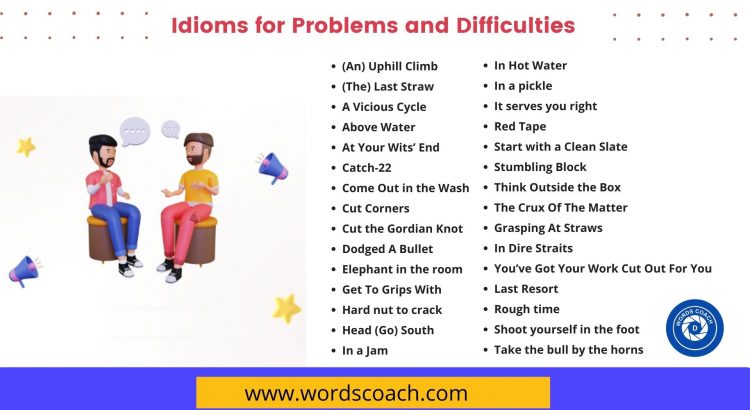

30+ Useful Phrases & Idioms for Problems and Difficulties
Problems and Difficulties Idioms and Phrases! Learn common Problems and Difficulties Idioms, Phrases, and sayings in English with meaning and example sentences.
Idioms for Problems and Difficulties
List of 30+ Useful Making Decisions Idioms and Phrases in English
(An) Uphill Climb
Meaning: A difficult process
Example: The course was designed to give them a running start on their steep uphill climb through the curriculum.
(The) Last Straw
Meaning: A problem or insult that finally demands a response
Example: Transport pressure groups believe this will be the last straw for some services.
A Vicious Cycle
Meaning: when one problem causes another problem, which then causes the first problem again
Example: Security forces and militants are locked in a vicious cycle of killing.
Above Water
Meaning: Not in extreme difficulty. Especially said of finances
Example: We are keeping our head above water, but our cash flow position is not too good.
At Your Wits’ End
Meaning: when you are at the limit of your mental resources, desperate and without additional options
Example: I’ve been trying to download the file all day and I keep getting an error message – I’m at my wits’ end!
Meaning: a situation in which it’s impossible to succeed because of conflicting rules or conditions
Example: It’s a Catch-22 situation – without experience you can’t get a job and without a job you can’t get experience.
Come Out in the Wash
Meaning: be resolved eventually with no lasting harm
Example: The real reasons for her resignation will come out in the wash.
Cut Corners
Meaning: Economize by reducing quality; take shortcuts
Example: Take your time, don’t cut corners and follow instructions to the letter.
Cut the Gordian Knot
Meaning: solve or remove a problem in a direct or forceful way, rejecting gentler or more indirect methods.
Example: Let’s cut the Gordian knot in doing with such a complicated matter.
Dodged A Bullet
Meaning: barely escaped from a dangerous/disastrous situation
Example: Bush dodged a bullet when Chavez was forced out.
Elephant in the room
Meaning: An obvious problem that people do not want to talk about
Example: “Elephant in the room” is an English idiom for an obvious truth that is being ignored or goes unaddressed.
Get To Grips With
Meaning: To begin to understand and deal with something
Example: They were so keen to get to grips with the enemy that they disregarded much of the training in stealth and guile.
Hard nut to crack
Meaning: A problem that is hard to solve or a person who is difficult to understand
Example: This problem is going to be a hard nut to crack.
Head (Go) South
Meaning: Decline, get worse
Example: The markets all headed south after the bad economic news.
Meaning: In need of help, in a difficult spot
Example: The knives and forks were kept in a jam jar.
In Hot Water
Meaning: In need of help; in trouble
Example: Wool usually damages if washed in hot water.
Read: 150+ Famous American Idioms
In a pickle
Meaning: Someone that has a big problem
Example: Companies find themselves in a pickle when their markets change.
It serves you right
Meaning: Your problem is the result of your own bad behaviour, and you deserve it
Example: Left you, did she? It serves you right for being so selfish.
Meaning: Difficult bureaucratic or governmental requirements
Example: The new rules should help cut the red tape for farmers.
Start with a Clean Slate
Meaning: To start (something) again with a fresh beginning; to work on a problem without thinking about what has been done before
Example: Start with a clean slate every time you move onto a new project.
Stumbling Block
Meaning: An obstacle, physical or abstract
Example: The main stumbling block to starting new research is that we lack qualified people.
Think Outside the Box
Meaning: Try to solve a problem in an original way; think creatively
Example: Our product line is getting stale. We need to think outside the box and come up with creative new products.
The Crux Of The Matter
Meaning: the most essential or main part of the problem
Example: The crux of the matter is how do we prevent a flood occurring again?
Grasping At Straws
Meaning: when you’re desperate and you’re pursuing even the slightest hope or possibility (even if it probably won’t work)
Example: For now, researchers admit that they are still grasping at straws.
In Dire Straits
Meaning: in a very serious, very bad situation
Example: After the war the county’s economy was in dire straits.
You’ve Got Your Work Cut Out For You
Meaning: when you have a large and difficult task to do in the future
Example: You want to finish a four-year college degree in just two years? Well, you’ve got your work cut out for you.
Last Resort
Meaning: an option you use as a “last chance” when there are no other options available
Example: Strike action should be regarded as a last resort, when all attempts to negotiate have failed.
Meaning: To have many problems
Example: All women have a rough time in our society.
Shoot yourself in the foot
Meaning: To do or say something that causes problems for you
Example: Why does Kerry always shoot herself in the foot by saying the wrong thing?
Take the bull by the horns
Meaning: Deal with a problem in a direct and fearless way
Example: Nora decided to take the bull by the horns and organize things for herself.
The Tip Of The Iceberg
Meaning: only a small part of the problem; the biggest part of the problem is hidden
Example: These small local protests are just the tip of the iceberg.

Related Posts:
- 100 Psychology Skills to master your life
- Action Verbs List, definition and Example Sentences
- 50+ Sentences about Cycle in English
- 150+ Idioms about Money and Finance
- Idioms beginning with A
- 120+ Phrases & Idioms about Sales and Marketing
- Verb Definition And Verb Examples Sentences
- 200+ Friendship Day Quotes
Leave a Reply Cancel reply
Your email address will not be published. Required fields are marked *
Save my name, email, and website in this browser for the next time I comment.
Download the Word coach App on your Android phone
Word Coach - IELTS and GRE Vocabulary Builder & word coach Quiz (10 Words a Day) application helps, you and your friends to improve English Vocabulary and help you become the smartest among your group.

10 Idioms for Problems & Difficulties

300+ Idioms Course
#1 – at your wits’ end
= when you are at the limit of your mental resources, desperate and without additional options
“I’ve been trying to download the file all day and I keep getting an error message – I’m at my wits’ end !”
#2 – catch-22
= a situation in which it’s impossible to succeed because of conflicting rules or conditions
“Getting your first job is a catch-22 because companies want to hire someone with experience, but how can I get experience unless someone gives me a job?”
#3 – dodged a bullet
= barely escaped from a dangerous/disastrous situation
“One of my ex-boyfriends later became a drug dealer! I’m glad I broke up with him – I definitely dodged a bullet .”
#4 – the crux of the matter
= the most essential or main part of the problem
“Of course there are a number of things that the country needs to improve, but the crux of the matter is that the politicians are corrupt.”
#5 – grasping at straws
= when you’re desperate and you’re pursuing even the slightest hope or possibility (even if it probably won’t work)
“The police are grasping at straws because there’s virtually no evidence at the crime scene.”
#6 – in dire straits
= in a very serious, very bad situation
“Harry has been unemployed for the past three years – he’s really in dire straits .”
#7 – you’ve got your work cut out for you
= when you have a large and difficult task to do in the future
“You want to finish a four-year college degree in just two years? Well, you’ve got your work cut out for you .”
#8 – last resort
= an option you use as a “last chance” when there are no other options available
“If we can’t stay with any of our friends in London, then we can always book a hotel as a last resort .”
#9 – the tip of the iceberg
= only a small part of the problem; the biggest part of the problem is hidden
“My parents’ arguing about where to go on vacation was only the tip of the iceberg ; they treated each other horribly throughout their marriage.”
#10 – a vicious cycle
= when one problem causes another problem, which then causes the first problem again
“When I gain weight, I have less energy to exercise… and when I do less exercise, I gain even more weight. It’s a vicious cycle .”
Learn more:
- All about idioms in English
- 100 idioms + examples
A fun & easy way to learn English idioms

More Espresso English Lessons:
About the author.
Shayna Oliveira
Shayna Oliveira is the founder of Espresso English, where you can improve your English fast - even if you don’t have much time to study. Millions of students are learning English from her clear, friendly, and practical lessons! Shayna is a CELTA-certified teacher with 10+ years of experience helping English learners become more fluent in her English courses.
About Words – Cambridge Dictionary blog
Commenting on developments in the English language

Take the rough with the smooth (Idioms to describe dealing with problems)

Starting with the positive, if you are in a difficult situation and you take it (all) in your stride (UK) / take it in stride (US) , the situation does not upset or worry you: Sarah often has problems with staff but she takes it all in her stride. Someone who weathers the storm or rides the storm is not harmed during a difficult period. You might say this of a person whose reputation is not damaged despite difficulties: For a while, the scandal threatened to destroy the president, but somehow he weathered the storm. Meanwhile, to get/come to grips with a difficult situation or task means to succeed in starting to deal with it: This is a problem that the government really needs to get to grips with.
Most people regard interviews and exams as difficult situations. A person who succeeds very easily in such a situation may be said to sail through it: She’s very impressive – I’m sure she’ll sail through the interview.
Some idioms describe a person’s attitude towards a problem rather than their success or failure in dealing with it. If you grit your teeth , you show determination in a difficult situation. (To grit your teeth literally means ‘to press your top and bottom teeth together, often in anger’): The next few weeks will be tough but he’ll just have to grit his teeth and get on with it. Someone who accepts a difficult situation, knowing that they cannot change it may be said to grin and bear it : I don’t want to do it but I don’t have much choice so I guess I’ll just have to grin and bear it. Of course, in many situations there are both good and bad aspects. To accept the difficult or unpleasant parts of a situation as well as the good parts is to take the rough with the smooth : No long-term relationship is perfect, and to some extent, you have to take the rough with the smooth.
Finally, there are few situations more difficult to deal with than the death of a person that you love. A phrase that is often used to describe the process of gradually accepting that particular sad situation is to come to terms with it: His wife died two years ago and he’s still coming to terms with it.
Share this:
- Click to share on Facebook (Opens in new window)
- Click to share on Twitter (Opens in new window)
- Click to share on Reddit (Opens in new window)
- Click to email a link to a friend (Opens in new window)
- Click to print (Opens in new window)
- Click to share on LinkedIn (Opens in new window)
- Click to share on Pinterest (Opens in new window)
Discover more from About Words - Cambridge Dictionary blog
Subscribe now to keep reading and get access to the full archive.
Type your email…
Continue reading
Mastering English Idioms for Problem-Solving
- Post author: Harry
- Post last modified: 03/10/2023
- Post category: English Idioms
- Reading time: 11 mins read
Mastering English idioms for problem-solving will help you improve your speaking skills. In this lesson, you’ll learn advanced English idioms that can help improve your speaking and make you better at English.
If you’re trying to get better at English, maybe for tests like IELTS, CAE, or TOEFL, or just to speak more like a native speaker with confidence, this lesson can help you a lot.
Listen to the podcast Speak Better English with Harry or watch it on YouTube at Learn English with Harry . englishclass101
list of english idioms
Today, we’re going to explore a fascinating topic that can help you understand English better and make your conversations more interesting. We’ll be diving into ’10 Idioms Related to Problems and Difficulties.’ Idioms are like secret codes in English that express ideas in fun and creative ways.
By learning these idioms, you’ll be able to talk about challenges and difficulties just like a native speaker. So, let’s get started.
Free English Language Course Online

How to Teach English Online Course
At your wits’ end.
Meaning: being extremely frustrated or unable to find a solution to a problem
In the math exam, I couldn’t solve the last question, and I was at my wits’ end.
I asked the bank for a loan, but it was denied. I asked my parents for help. I’m really at my wits’ end.
to be grasping/clutching at straws
Meaning: to desperately seek a solution when there are few or no options left
I lost my wallet and had no money. I searched the park, hoping to find it, but I was clutching at straws.
Clutching at straws, Sarah asked for an advance on next month’s salary to cover unexpected expenses.
I was clutching at straws, desperately seeking an extension for my assignment deadline.
I often see students clutching at straws as they try to find ways to get deadline extensions.
to go south
Meaning: something is not going well or has become worse
My life has gone south – my relationship broke up, my landlord increased the rent, and I lost my job due to budget cuts.
The stock market often goes south when unexpected economic factors come into play.
The performance of Manchester United has gone south recently, sparking disappointment among fans.
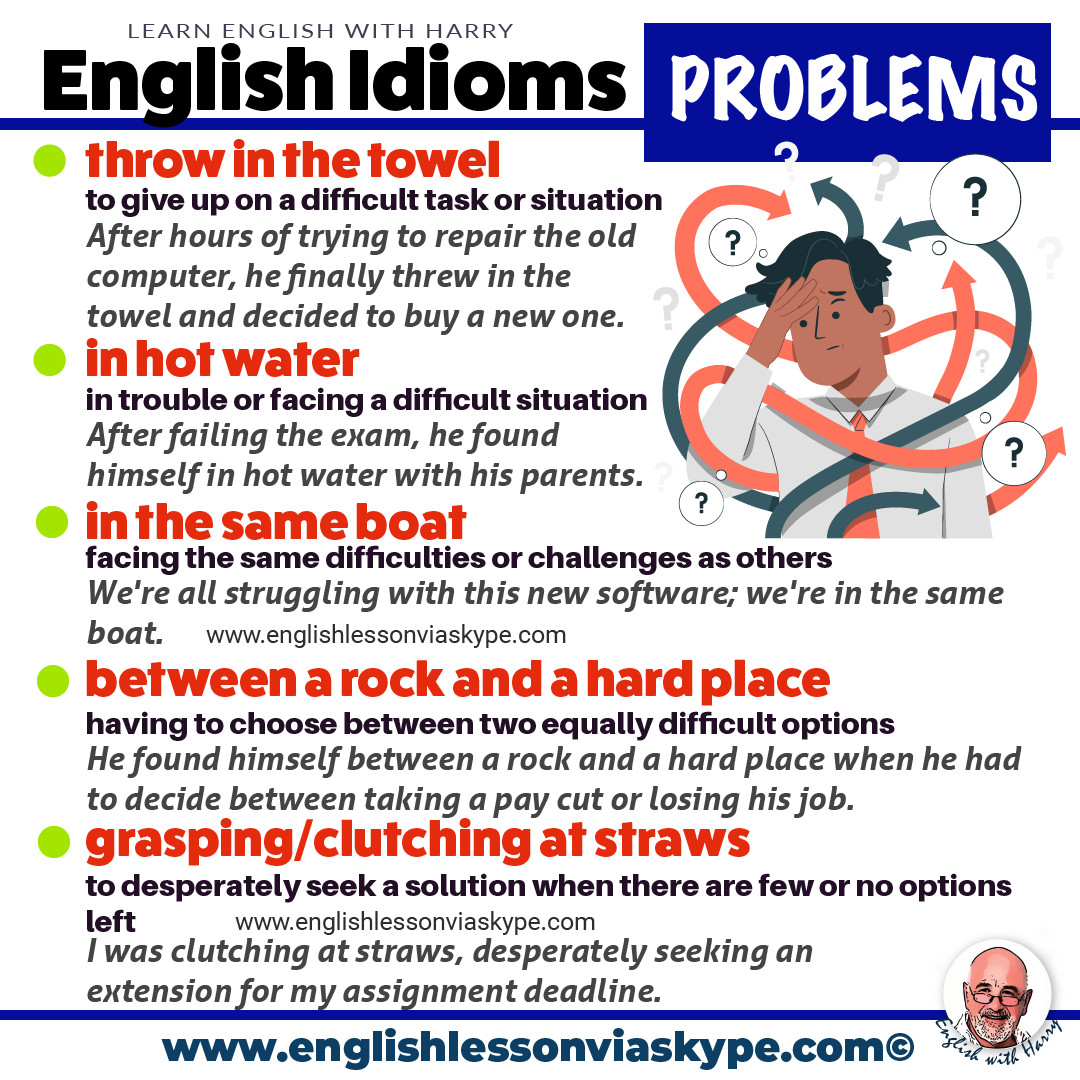
in hot water
Meaning: to be in trouble or facing difficulties due to a mistake or wrongdoing
John found himself in hot water when he realised he had forgotten his wife’s birthday.
Michael was in hot water with his boss after failing to send the report on time.
Emily ended up in hot water with her lecturer when she failed to hand in her paper on time.
to have you back to/ against the wall
Meaning: to be in a difficult situation with limited options and feeling trapped
With his back to the wall financially, Mark had to take on a part-time job to make ends meet.
My back’s against the wall. If I don’t complete this report now, we won’t be able to collect the fees.
When I lost my wallet and had no money, I felt like my back was against the wall.
Meaning: a problem with no good solution because two rules or conditions conflict with each other.
I wanted to buy a car, but I needed a job for money, and I needed a car to get to the job. It was a catch-22.
I needed a job to get experience, but every job required experience. It was a catch-22.
book your trial English Lesson
A can of worms.
Meaning: a complicated or difficult situation that, once opened or started, becomes even more complicated or problematic
Bringing up that topic at the family dinner opened a whole can of worms.
Lisa’s relationship with her boyfriend is complicated. I’d suggest not getting too involved; it’s a real can of worms.
I wouldn’t touch this account; it’s a real can of worms.
vicious circle
Meaning: a cycle of problems that keep getting worse
His debt led to stress, which affected his job, and losing his job worsened his debt. It was a vicious circle.
The boss wants us to do this, but accounts want the customer to pay, and they won’t – it’s a vicious circle.

think on your feet
Meaning: to make quick decisions or come up with solutions in a fast-paced and unexpected situation
During the interview, I had to think on my feet and quickly answer unexpected questions.
It’s important to be able to think on your feet when unexpected tasks or challenges arise.
have a lightbulb moment
Meaning: suddenly understand something or have a bright idea
While I was taking a shower, I had a lightbulb moment and came up with a brilliant idea for our project.
During math class, I had a lightbulb moment when I finally understood how to solve multiplications.
So those are all idioms, they are quite difficult idioms relating to problems and difficulties in your life in work, whatever it might be. Okay, let me go through them one more time:
As I mentioned before, if you want to practice these English idioms related to problems, please go ahead. If you have any problems or need more examples, you can reach out to me through the website www.englishlessonviaskype.com . I’m always glad to hear from you. If you have any questions, or concerns, or want to improve your English, just send me a message.
Thank you for joining us; we really appreciate it.
speak better English with Harry podcast- episode 451
More information.
For more information on English grammar rules, English collocations and English idioms, check out the links below:
Advanced adjectives to describe travel experiences
Common phrasal verbs with UP
You can always study English advanced level at Learning English with the BBC and British Council Learn English .
Fixed English Expressions about Health
Here you will learn English fixed expressions about health and also learn how to describe your symptoms to a doctor

Phrasal Verbs About Thinking And Learning
Learn phrasal verbs about thinking and learning. Learn advanced English vocabulary. New phrasal verbs will help you improve your everyday
enrol in a free course

- Phrasal Verbs + Grammar + Funny English Idioms
online english courses from €7.99
- free english mini course
- english grammar refresher
- 73 most common mistakes
- Advanced english workout 1
- advanced english workout 2
- advanced english workout 3
- job interview in english
- how to teach english online
follow me on social media
Advanced english learning course.
Improve English from intermediate to advanced level in my intensive English course.
55 online lessons + 6 online courses + direct contact with Harry
learn english with us
- zoom/skype english lessons prices
- our teachers
- english learning blog
- Odnoklassniki icon Odnoklassniki
- Facebook Messenger
- LiveJournal
How can I advance my English?
Idioms for Problems and Difficulties | List of Idioms for Problems and Difficulties With Meaning and Examples
Idioms for Problems and Difficulties: Idioms are preconceptions that represent a nation’s culture. Idioms are word groupings that commonly deviate from their literal meaning. Idioms are made up of at least two words that cannot be altered.
A word does not make a statement, thus it must have two words. Learning a language’s idioms helps us a lot while speaking it.
Idioms include language patterns that represent a circumstance or notion, which separates them from proverbs. Proverbs contain components such as guidance and teachings. Because idioms are usually metaphorical, there are discrepancies between the words and the meaning.
To make learning even more complex, there are idioms for solving problem, or idioms about ignoring problems, which are already densely packed with jargon that even native English speakers struggle to comprehend.
While idioms are typically metaphorical in nature, they are rarely employed in real speech.
Below are some of the most frequent English idioms for achieving the impossible and to boost one’s confident, there are other idioms for problems and difficulties, along with a brief explanation, to aid English as a Second Language learner.
Enrich your Vocabulary by practicing the English Idioms that are commonly used in everyday conversations and understand their actual meaning.
Names of Idioms for Problems and Difficulties
Meaning and examples of some commonly used idioms for problems and difficulties, list of idioms for problems and difficulties, at your wits’ end, catch-twenty two, dodged a bullet, the crux of the matter, grasping at straws, in dire straits, you’ve got your work cut out for you, last resort, the tip of the iceberg, a vicious cycle, (an) uphill climb, (the) last straw, above water, come out in the wash, cut corners, cut the gordian knot, get to grips with, head (go) south, in hot water, start with a clean slate, stumbling block, think outside the box.
- Catch-twenty two.
Dodged a bullet
The crux of the matter, grasping at straws, you’ve got your work cut out for you, the tip of the iceberg, throw money at something, throw it over the wall, tip of the iceberg, twist in the wind, unmitigated disaster, an uphill battle, a vicious circle, wave a dead chicken, the wheels fall off, without a hitch, work cut out for you, a yoke around your neck, go pear-shaped, go through the mill, when the going gets tough, grasp at straws, hang (someone) out to dry, leave high and dry, in dire straits, leave in the lurch, in over your head, juggle frogs, a last resort, see light at the end of the tunnel, a millstone around your neck, a necessary evil, one’s number is up, ostrich strategy/policy, out of sync, out of whack, paper over the cracks, pass the buck, in a pickle, no quick fix, put on a brave face, ride it out / ride out the storm, saved by the bell, scratch the surface, where the shoe pinches, a shoulder to cry on, put a spanner in the works / throw a monkey wrench, spell trouble, spiral out of control, on a sticky wicket, stir up a hornet’s nest, stop the rot, a stumbling block, take the bull by the horns, take the easy way out, teething problems, a thorny issue.
- Cloud on the horizon
Come to a head
Come hell or high water, come out in the wash.
- cross to bear
Cross that bridge when we come to it
(the) crux of the matter, a dead man walking, disaster written all over it, dodge a bullet, an elephant in the room, the fat hits the fire, get to the bottom (of something).
Meaning: You are at the end of your mental resources, you are desperate.
Example: Rina has been attempting to download the work file all day, and she keeps receiving an error message – Rina is at my wits’ end!
Meaning: you are in a position where it is difficult to achieve because of contradictory norms or circumstances.
Example: Getting your first work is a Catch-22 situation; employers want to hire somebody with experience, but how am I to gain experience until someone offers me a job?
Meaning: In narrowly dodged a potentially dangerous or terrible scenario.
Example: Rachel ex-boyfriend went on to become a drug dealer! She is fortunate that she ended their relationship – she definitely dodged a bullet.
Meaning: The most important or most significant aspect of the situation.
Example: No doubt, the country has to improve in a lot of areas, but the crux of the matter is that the politicians are crooked.
Meaning: You are desperate, and you are seeking even the tiniest hope or chance (even if it seems likely that it would not succeed) when you are in desperation.
Example: Because there is almost little evidence at the crime site, the cops are grasping at straws.
Meaning: This is a really critical and extremely awful situation.
Example: Benedict has been jobless for three years and is in serious financial problems – he’s really in dire straits.
Meaning: In the event that you have a huge and tough assignment to do in the near future.
Example: If you want to earn a four-year college degree in two years instead of four? Well, you’ve got your work cut out for you.
Meaning: When there are no other alternatives available, you might utilise this option as a “last resort.”
Example: If none of our friends is available to host us in London, we may always hire a hotel as a last resort.

Meaning: Only a small portion of the problem is visible; the majority of the problem remains concealed.
Example: My parents’ quarrels over where to go on vacation were just the tip of the iceberg; they were abusive to each other throughout their marriage.
Meaning: When one problem results in another problem, which then results in the initial problem occurring once more.
Example: As I have less stamina to exercise, I gain weight, and when I reduce my exercise, I acquire even more weight. It’s a vicious cycle.
Meaning: When is a tough procedure.
Example: It will be difficult and is going to be an uphill climb to regain our confidence when you have already stolen from us, but we believe you can accomplish it if you are cautious about acting honestly.
Meaning: An issue or an insult that, at long last, necessitates a reaction.
Example: Rudy bringing food to his office is always a pain, but today he brought a durian. That’s the last straw; I’m going to the manager to complain.
Meaning: Not in a state of great peril. This is particularly and exceptionally true in the case of finances.
Example: We aren’t wealthy, but we are able to keep our heads above water.
Meaning: In order to be addressed without causing any long-term harm.
Example: You appear to be dealing with a lot of issues right now, but don’t worry; it will all come out in the wash.
Note: This is most commonly used in the phrase “it’ll all come out in the wash.”
Meaning: Reduce the quality of your work to save money; use shortcuts.
Example: Let’s not cut corners on the rooftop materials – we’ll pay for it later, especially with the rainstorms we’ve had recently.
Meaning: To find a solution that is quite simple to a complicated situation.
Example: When the majority of us are wrestling with details, William sees easy answers. He has a knack for cutting the Gordian knots.
Note: This unusual phrase is based on a tale about Alexander the Great, who, when unable to untie a knot with his sword, cut it with his sword.
Meaning: To make an attempt to comprehend and deal with something.
Example: I believe it is time for us to get to grips with the issue of rising competitiveness.
Note: In the United States, the phrase “come to terms with” is used.

Meaning: Decline and deterioration.
Exampl e: Following the terrible economic news, the markets all headed south.
Meaning: In need of assistance, in a tough situation.
Example: My roommate stated she had been in a pickle and required a $20 loan, so I gave it to him.
Note: Unlike “in a pickle” or “in a jam,” this phrase can be used with the word “with” to indicate being in difficulty with someone.
Meaning: In need of assistance; in distress.
Example: After blowing that sales presentation, Cathy is in hot water with her department supervisor.
Meaning: Bureaucracy; bureaucratic or governmental regulations that are difficult to comply with.
Example: In this city, the amount of red tape required in constructing something is incredible.
Meaning: Starting again with a clean slate; working on an issue without reference to previous work.
Example: With this endeavour, we’ve come to a halt. I believe it is preferable to wait till next week and start with a clean slate.
Meaning: An impediment, whether physical or metaphorical.
Example: I like this profession, but the social elements of it are difficult for me – the shyness that I possess has always been a stumbling block for me.
Meaning: Try to manifest a novel solution to an issue; be imaginative in your thinking.
Example: Our product line is starting to become stale. All of us must try to think outside the box in order to develop innovative and new consumer items.
Meaning: An issue or a scenario in which the desired goal is difficult to attain as a result of the existence of conflicting or illogical laws, regulations, or circumstances.
Example: The firm had a cost-cutting strategy that was a Catch-22: they needed to reduce the number of staff to stay active, but they also needed to finish the projects.
Meaning: Something or a circumstance that might be unpleasant and have potentially devastating effects must be avoided to the greatest extent possible.
Example: Shikha got lucky and dodged a bullet when her engagement was called off since she subsequently learned that the prospective groom had been arrested for domestic abuse.
Meaning: When someone’s thoughts and mental resources have been spent, and they are highly angry and annoyed that they don’t become aware of what to do next, they are said to be in this state.
Example: Firoz was at his wits’ about what to do to keep the youngsters entertained.
Meaning: The fundamental, core, or crucial aspect of a problem.
Example: The few strands of hair recovered near the carpet were the core of the evidence or rather the crux of the matter in the murder case.
Meaning: When you are really desperate, you will chase any hope or option, even if the probability of success is extremely slim or non-existent.
Example: The conservative pundit began grasping at straws for a sense of success after being thoroughly beaten in the debate.
Meaning: When faced with a life-threatening or catastrophic circumstance.
Example: Hemant was already in dire straits after being busted with narcotics at school, and he had no idea what awaited him at home.
Meaning: This is an option that you use as a final resort when all other alternatives have been exhausted.
Example: When the hitchhikers were unable to find a motel for their night, they opted to pitch their tent in the forest as a last resort.
Meaning: When you are faced with a massive and tough assignment, it is important to be calm and focused.
Example: Mohan had intended to do two post-graduate degrees in the same year. He had a lot of work cut out for him.
Meaning: When one problem produces another problem, which in turn causes another problem, which in turn causes the initial problem, we have a vicious cycle.
Example: In India, the vicious cycle of poverty is a major concern.
Example: The accounting scam was only the tip of the iceberg in the company’s huge financial disaster.
Meaning: If you throw money at something, you are attempting to address an issue only via the expenditure of money rather than by the use of other techniques.
Example: The refugee crisis will not be solved simply by throwing money on it and not providing them with jobs.
Meaning: A person who tosses things over the wall is someone who deals with part of a problem or project before passing the burden to another person or department without communicating with or coordinating with the others.
Example: You can’t just make a product and then throw it over the sales department’s wall!
Meaning: When you tide someone over, you are assisting them in getting through a tough moment for a specified amount of time.
Example: We can’t go to the store because of the weather, but we have sufficient food to tide us over until next week.
Meaning: Someone who finds themselves in a tough circumstance is in a very difficult predicament.
Example: The airline firm is in a tight spot as a result of the current strike.
Meaning: The tip of the iceberg refers to the portion of an issue or situation that is known but is believed to be far more serious than it actually is.
Example: Journalists claim that the corruption study just looks at the tip of the iceberg.
Meaning: This phrase is used to describe a scenario that is even more difficult to deal with than a dilemma since a decision must be made between three choices that appear to be equally unpalatable to the individual.
Meaning: When someone is left to twist in the wind, they are left to deal with a tough issue on their own, without any aid or assistance from others.
Example: He left his agent twisting in the wind as he walked out of the news conference.
Meaning: A complete failure or a comprehensive catastrophe is referred to as an unmitigated calamity.
Example: The tournament’s organisation was an unmitigated disaster!
Meaning: A person who is fighting an uphill battle must contend with extremely unfavourable circumstances.
Example: His rehabilitation after the horrible tragedy was an uphill battle all the time.
Meaning: A vicious loop is a scenario in which the solution to a problem causes another problem that is similar to or worse than the initial problem, resulting in the process being repeated over and over again.
Example: To repay Paul, I took out a loan. Now I have to repay the bank, plus interest. It’s a vicious cycle.
Meaning: When confronted with a significant situation, if you do something that you know would be fruitless in order to demonstrate that you made an attempt, you wave a dead chicken in the air to demonstrate that you made an effort.
Example: The TV set was irreparably broken, but the technician chose to appease the elderly lady by waving a dead chicken before breaking the terrible news.
Meaning: When a situation spirals out of control, and everything begins to go wrong, the wheels come off the bus.
Example: When she began doing drugs and cancelling gigs, the wheels started falling off of her career and came to a halt.
Meaning: Whenever anything goes off without a hitch, it means that everything happens just as intended and without any complications.
Example: To our great relief, the ceremony went off without a hitch!
Meaning: If you are faced with a difficult assignment or a difficult scenario, you will have your work cut out for you.
Example: I have a month to restructure the accounting department. My task is to work cut out for me!
Meaning: A yoke around your neck is a term used to describe a duty, commitment, or constraint that has become an onerous weight.
Example: When John’s job was destroyed, the housing payments became a yoke around his neck.
Meaning: In the case of anything going haywire, it gets disorganised or becomes out of control.
Example: The photocopier has totally malfunctioned and gone completely haywire. Only half of each page is printed!
Meaning: When a plan or effort goes awry, it either goes horribly wrong or yields an unfavourable outcome.
Example: Jane planned a treasure hunt for the kids at the park, but everything went pear-shaped, and everyone was unhappy.
Meaning: If you are put through the mill, you will either go through a really tough phase or be subjected to harsh punishment.
Example: I was put through the mill and wringer as an intern. There was no detail that went overlooked.
Meaning: This statement indicates that when confronted with a tough or hazardous circumstance, strong individuals take action to resolve the situation.
Example: Tom has a cheerful demeanour. ‘When the going gets tough, the strong get moving,’ he often remarks.
Meaning: Whenever you’re in a desperate position, and you’re grasping at straws, you’ll try every approach you can think of in an attempt to find a solution, no matter how unlikely it is to be successful.
Example: He resorted to a faith healer in his hunt for a cure, knowing full well that he was grasping at straws.
Meaning: Leaving someone who is experiencing difficulties without providing any aid or support is equivalent to hanging them out to dry.
Example: Jack isn’t going to be of any use to you. If your strategy fails, he’ll hang you out to dry.
Meaning: If one is left high and dry, that person will find themself in a tough circumstance where you will have no access to assistance or resources.
Example: Eva was left high and dry with two children after her spouse walked out on her.
Meaning: If a person or organisation finds itself in a precarious financial condition, they are in an extremely tough predicament.
Example: The firm is in dire straits as a result of the loss of significant contracts.
Meaning: In the event that anything leaves you in the lurch, you may find yourself in an uncomfortable or humiliating scenario.
Example: Paul was left in the lurch after missing the last bus.
Meaning: Getting yourself into trouble is getting yourself involved in something too tough for you to handle.
Example: I agreed to organise the event, but I immediately realised I was in over my head.
Meaning: A person who is juggling frogs is attempting to manage a large number of things at the same time and is finding the situation challenging.
Example: I feel like I’m juggling frogs right now since I have so many things to accomplish!
Meaning: As a last resort, it indicates that you would do something only if all other options had been exhausted and all other ways of achieving your goal had been exhausted.
Example: I still haven’t located a motel for the night; as a last resort, I can always sleep in the vehicle!
Meaning: Having a problem or obligation that becomes a cause of stress and anxiety is referred to as having a millstone around your neck or being a burden.
Example: Last year’s sales were down significantly, but we’re starting to see the light at the end of the tunnel.
Example: He wore a millstone around his neck because of the money he borrowed.
Meaning: When something is murderous, it is extremely difficult or painful to deal with.
Example: The trip home through the storm was a complete murder!
Meaning: When you say something is a necessary evil, you are acknowledging that you do not agree with it but realise that it must exist and be tolerated.
Example: For those who wish to travel, vaccinations are an unnecessary evil.
Meaning: When someone’s number is called, it indicates that they are either in great trouble and that something horrible is about to happen or that the time has arrived for them to die.
Example: The police have apprehended the fugitive prisoner, and it appears that his number is up!
Meaning: Ostrich strategies and policies are used when someone decides to ignore or dodge a clearly defined problem in the expectation that it will resolve itself or disappear.
Example: Avoiding the issue would and adopting an ostrich strategy will only make things worse; we must find a solution as soon as possible.
Meaning: It is not coordinated if two movements or activities occur at the same time or at the same pace if they are not in sync with one another.
Example: The traffic lights present on the opposite side of the road appear to be out of sync, and this is generating a high level of uncertainty for drivers.
Meaning: When something is out of whack, it means that it is not functioning correctly or that it is not in excellent operating condition.
Example: Unusual noises are getting emanate from the dishwasher. Something is definitely out of whack.
Meaning: To suggest that someone is “papering over the cracks” refers to the fact that they are attempting to conceal an issue rather than properly dealing with it.
Example: The efforts adopted to minimise unemployment are only paper over the cracks that have already been opened.
Meaning: When you claim that someone is “passing the buck,” you are accusing them of failing to accept responsibility for an issue and instead entrusting others with the task of dealing with it.
Example: When a client comes in to complain, she always manages to appear busy, which is a fantastic way to passing the buck.
Meaning: If one finds themself in a pickle, you are in a tough situation and want assistance.
Example: The problem is that my car won’t start, and the trains are not running today, so I’m in a pickle!
Meaning: When someone says that there is no easy answer to an issue, they are referring to the fact that there is no quick cure.
Example: There is really no quick fix for poverty and unemployment; instead, significant adjustments are required.
Meaning: Even when presented with challenges, it is important to maintain your composure and pretend that the situation is not as tough as it appears to be.
Example: Even in the most difficult of circumstances, she maintained her composure and put on a brave face.
Meaning: It is called riding it out if you manage to endure a risky or extremely unpleasant circumstance, such as being on a ship sailing during a storm.
Example: His company was negatively impacted by the recession, yet he was able to manage to ride it out.
Meaning: Whenever you are rescued by the bell, something happens at the last minute to save you from a dangerous scenario.
Example: When I discovered I didn’t have any money for the parking metre, a buddy came just in time—saved by the bell!
Meaning: When you merely scratch the surface of an issue or subject, you are only dealing with a small fraction of it, according to the definition.
Example: When it comes to their environmental challenges, several countries have just scratched the surface.
Meaning: When individuals talk about ‘where the shoe pinches,’ they are referring to a region that is frequently a source of difficulties or issues.
Example: She is certain that the public transportation system is faultless, but she will soon discover where the shoe pinches when she begins to use it!
Meaning: It is necessary to speak with someone who will listen to your concerns and offer compassion and support when you are sad if you are in need of “a shoulder to weep on.”
Example: If you need a shoulder to cry on, you may reach out to me at any moment.
Meaning: The phrase “putting a monkey wrench in the works” refers to causing complications and preventing anything from occurring in the manner it was intended.
Example: A new highway was being built, but a group of environmentalists managed to throw a monkey wrench in the works.
Meaning: If anything indicates difficulties, it indicates that there may be issues in the future.
Example: The extended cold weather will have a negative impact and spells trouble on this year’s harvest.
Meaning: It is difficult to handle a situation when issues or costs spiral out of control because they grow worse or continue to rise on an ongoing basis.
Example: Even though some of the goods were pricey, we were careful not to allow the expenses to spiral out of control.
Meaning: Whenever you find yourself in a sticky position, it means that you are in a tough scenario to deal with.
Example: Our situation has become a sticky wicket since they have refused to sign the contract!”
Meaning: A hornet’s nest is created when someone or something makes a disturbance and inspires criticism and outrage in the community.
Example: His letter to the Board of Directors stirs up a genuine hornet’s nest of controversy.
Meaning: The rot is stopped when you prevent a situation from worsening, which is very important in business and politics.
Example: As a result of the internal strife, new management was chosen in order to put a stop to the dysfunction and in order to stop the rot.
Meaning: A difficulty or barrier that hinders you from accomplishing your goals is referred to as a stumbling block.
Example: My father was able to adjust quite well, but my mother’s ability to communicate effectively was always a stumbling block.
Meaning: A person who decides to grab the bull by the horns is someone who makes a conscious decision to act decisively in order to cope with a tough circumstance or issue.
Example: When the conflict intensified into a physical altercation, the pub owner seized the bull by the horns and phoned the authorities.
Meaning: By taking the easy way out, you are choosing the quickest and most convenient method of dealing with a tough issue, even if it is not the most effective..
Example: Because of the inclement weather, Mary decided to take the easy way out and cancel her appointment.
Meaning: Generally speaking, this word refers to a sticky issue or problem for which it is nearly hard to bring up with a solution that is workable.
Example: He was urged not to become embroiled in the dispute, which was viewed as a ‘tar baby issue.
Meaning: Dentists refer to the challenges that arise at the beginning stages of an endeavour or undertaking as teething issues.
Example: Initially, we had some teething problems when we initially started the bookshop, but things are now working out fine for us.
Meaning: When you are confronted with a tough or unpleasant problem, you are said to be dealing with a thorny issue.
Example: Copyright and content duplication are two of the most thorny issues to deal with these days.
(A) Cloud on the horizon
Meaning: An ominous cloud on the horizon is a problem or issue that is predicted or that appears to be likely to occur in the near future.
Example: They are blissfully married, and for the time being, it appears like there are no clouds on the horizon or over their heads.
Meaning: The point at which a problem or tough situation reaches a boiling point is when it is necessary to take immediate action.
Example: In the middle of the night, violence came to a head yesterday in the streets, escalating the situation.
Meaning: In other words, when you state that you will do something no matter what, you are referring to the fact that you will do it regardless of the obstacles involved.
Example: Even if it means going through hell and high water, I have to be on time for the interview.
Meaning: This statement is used to urge someone not to be concerned about making a mistake or encountering a difficulty since it will have no significant impact and that everything will turn out OK.
Example: Yes, he was enraged when it occurred, but don’t panic – it’ll all come out in the wash in the long run.
(A) cross to bear
Meaning: Across to bear means that the individual has a major problem or a significant amount of duty that they must accept because they cannot change the situation.
Example: Alzheimer’s disease is a cross to bear that must be shared by the entire family.
Meaning: This is another way of expressing, “We will deal with that problem when it arises and will not be concerned about it beforehand.”
Example: What will happen if we are unable to pay back the loan? Then, we will cross that bridge when we come to it.
Meaning: The core of the problem refers to the most important or most significant aspect of a problem.
Example: In the end, the crux of the matter is that he’s too elderly to live alone in such a large mansion.
Meaning: A dead man walking basically means one who is certainly going to be in a lot of trouble very soon, especially if they are likely to lose their job or their position in the company.
Example: The minister presence has become a deadman man walking as a result of his handling of the recent riots in his country.
Meaning: If anything, such as a plan or a concept, appears to have catastrophe written all over it, it is presumed to be doomed to failure or to create significant disruption and disruption.
Example: There is nothing but disaster written all over Mary’s plan for a vacation with her in-laws.
Meaning: If you dodge a bullet, it means that you narrowly avoided a potentially life-threatening crisis or tragedy.
Example: When I missed the plane, I realised I dodged a bullet as it crashed shortly after take-off.
Meaning: It is referred to as an “elephant in the room” when an issue that no one wants to confront but that is so evident that it cannot be ignored.
Example: Face it: his work is disappointing, to say the least. It’s a major issue that has to be addressed since it’s the elephant in the room.
Meaning: A phrase that describes when difficulty breaks out or when a situation worsens as a result of anything said or done is “the fat strikes the fire.”
Example: Even though the situation was already tight, but the fat hits the fire when Larry is suspected of cheating.
Meaning: When you get to the bottom of an issue or mystery, you may fix it by discovering the root element of the problem or enigma.
Example: We are experiencing an issue with products vanishing during transportation. Hopefully, the inquiry will be able to find the source in order to get to the bottom of the case.
Leave a Comment Cancel reply
Save my name, email, and website in this browser for the next time I comment.
EnglishGrammarSoft
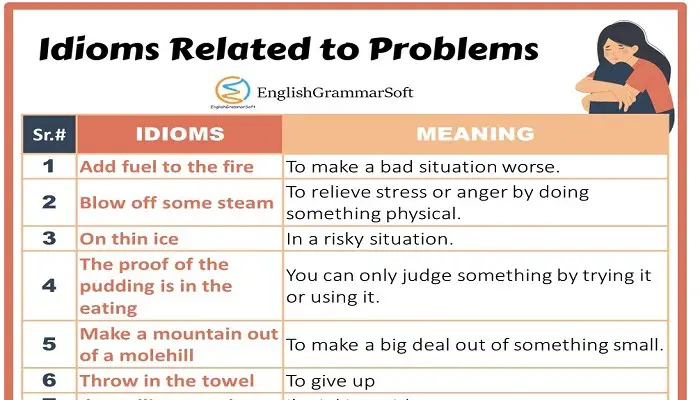
Useful English Idioms Related to Problems
Problems come in many different shapes and sizes. We can have big problems or small ones, personal problems or work-related ones. To discuss these problems in our daily conversation, we use idioms related to problems.
Idioms Related to Problems
Idioms are a huge part of our everyday language, but how many of us really know what they mean? Most of the time, we just memorize them because they sound good or they’re easy to remember. But if you really want to understand idioms and how they work, you’ve got to dig deeper. Here are some common ones to get you started:
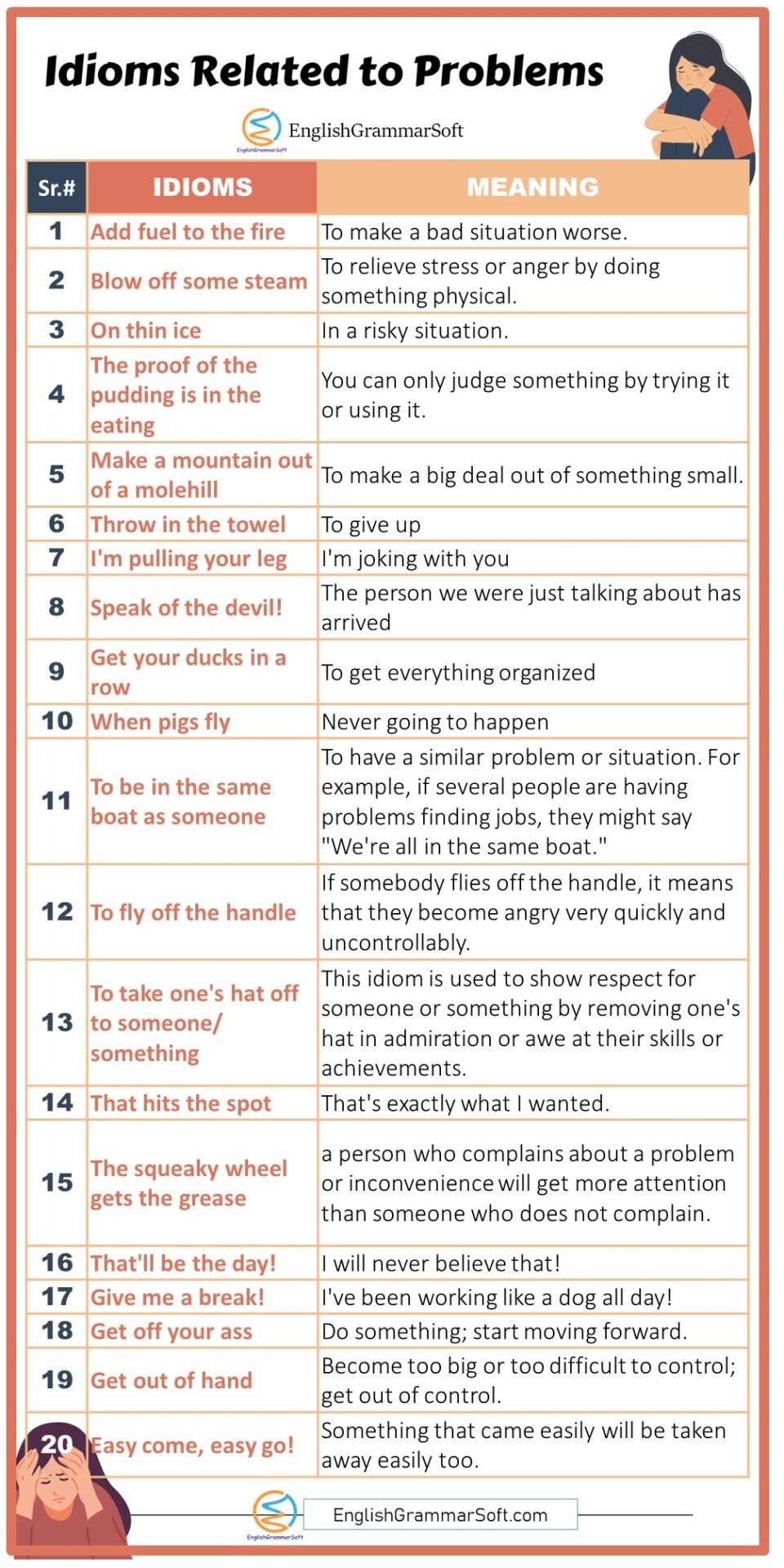
You might also like
- Types of Sentences
- Simple, Compound and Complex Sentences
- Idioms for daily use with meaning and examples
- Common Idioms for Students
20 Interesting Weather Idioms with Meaning
- Idioms Related to Animals with Meaning
Similar Posts

An Essay on School Life (Importance of School)
An Essay on School A school is a place for learning new skills, meeting friends, and preparing for adulthood. But there are so many more…

Regular and Irregular Nouns (Rules, Examples, Lists & Worksheet)
Regular and Irregular Nouns We can make some nouns plural easily without changing them but in some cases, nouns become irregular when we change them…

16 Tenses in English Grammar (Formula and Examples) Ultimate Guide
Tense is a modal aspect of the verb. There are 16 tenses in English Grammar in all. The tenses refer to the time of an…

When it comes to talking about the weather, there are all sorts of idioms and expressions that we can use to add some variety and…

Sentences with Commas (50 Examples)
Comma is the smallest punctuation mark that has the biggest effect. What is a comma? A comma is a mark showing the separation of different…

Simile and Metaphor Examples (50 Sentences)
Similes and metaphors are a great way to add some spice and help make your writing more interesting. For example, a simile is a sentence…
Leave a Reply Cancel reply
Your email address will not be published. Required fields are marked *
Save my name, email, and website in this browser for the next time I comment.

Page 1 of 5
grit one’s teeth
Meaning: to act bravely and courageously in a challenging situation.
Example: Tom gritted his teeth , overcame his fear of heights, and climbed the ladder. Read more ➺
fly in the ointment
Meaning: something that spoils a pleasant or enjoyable experience.
Example: The fly in the ointment was that the proposal still needed board approval. Read more ➺
catch a cold
Meaning: experience challenges and difficulties.
Example: Brian tried the offshore education business, but he caught a cold after the first month and has still shown no signs of growth. Read more ➺
Meaning: a sign of a particular issue requiring attention.
Example: United, American, and Delta airlines suspended all flights to China. This was a red flag as the coronavirus wreaked havoc on the airline industry. Read more ➺
the rose that grew from concrete
Meaning: a person who achieved greatness even though they came from a place not so great.
Example: Ken performed well despite his poor background, much like the rose that grew from concrete . Read more ➺
come to grief
Meaning: to have an accident or suffer disaster.
Example: Their relationship came to grief following their disastrous vacation. Read more ➺
rock the boat
Meaning: to make trouble .
Example: If you don't want any trouble with your boss, then stop rocking the boat . Read more ➺
hit the panic button
Meaning: prepare for disaster
Example: Dad's fishing pole dove into the lake without warning, and he hit the panic button before jumping up with the reel-spinning like crazy in his hand. Read more ➺
fiddle while Rome burns
Meaning: to perform an inconsequential task or act irresponsibly in the midst of a disastrous event.
Example: Vacuuming the carpet while her co-worker was in with the boss, trying to steal her job, felt like fiddling while Rome burned . Read more ➺
yoke around one’s neck
Meaning: a fatiguing burden.
Example: I refused to be the yoke around his neck , and so I turned down his generous offer of employment in a job for which I was unqualified. Read more ➺
An online community for new Manitobans
Problems & Solutions Idioms
Posted March 10, 2017 by Yuliana Bagan
Study the power point to get to know this week’s idioms.
Listen to the dialogue for better understanding and pronunciation.
Read the following dialogue to see the idioms in context:
Quiz time! Click to flip in the bottom right corner to see a definition. Click the next arrow to go to the next expression. Click Choose a Study Mode to select a different type of quiz for this vocabulary set. Remember! Practice makes perfect.
Problems & Solutions quiz
Quiz summary.
0 of 5 questions completed
Information
You have already completed the quiz before. Hence you can not start it again.
Quiz is loading...
You must sign in or sign up to start the quiz.
You must first complete the following:
Quiz complete. Results are being recorded.
0 of 5 questions answered correctly
Time has elapsed
You have reached 0 of 0 point(s), ( 0 )
Earned Point(s): 0 of 0 , ( 0 ) 0 Essay(s) Pending (Possible Point(s): 0 )
- Not categorized 0%
1 . Question
For a few months, crime investigation hadn’t yielded any results until police found sufficient forensic evidence which allowed them to ______________________ in the case.
- see light at the end of the tunnel
- take the bull by the horns
- bury their head in the sand
2 . Question
Jacquie had a loving relationship with her parents. Even though she had her own family now, she would always be close with them. So, when the relationship with her husband ________, the woman had all the support from her mom and dad.
- saw light at the end of the tunnel
- hit the rocks
3 . Question
Being a determined girl, Nora decided to ______________and invite the groupmate she liked out for a date.
4 . Question
He ______________because he couldn’t find a job without having an accommodation, and he couldn’t have an accommodation without having a job.
- buried his head in the sand
- was in a catch 22
5 . Question
When Angela saw her son, Jimmy, post inappropriate things online, she first tried to _______________ as if she hadn’t noticed. But then, she decided to talk to him about her concerns. She wasn’t a spy; after all, it was her duty as a parent to openly talk about it.
- bury her head in the sand
Join the Discussion
Please login to view the Discussion Forums. If you are not yet a registered learner, find out how to register .
← Previous Lesson Next Lesson →
To "Mark Complete" you must login and complete all the lesson topics.
e-Facilitator
Please login to view e-facilitator contact information.

Your Contact Details
Back to blog home.

- Problems at Work? Learn These 18 Idioms About Challenges
By Paola Pascual on Jun 29, 2020 1:13:40 PM
Being a non-native English speaker in such a competitive world can be tough sometimes, but you don’t have to roll with the punches . Instead, you can improve your communication skills and put yourself on a par with native speakers. Learn these idioms and phrases to talk about challenges at work, and don’t let the opportunity to shine at work slip through your fingers .
Idioms About Challenges
Here you have a list with the most common idioms about challenges and difficulties. Check it out and put them in practice at work or with a teacher:

Conversation questions
- Explain a time when you had to go back to the drawing board .
- When was the last time you had to bite the bullet ?
- Give an example of a bitter pill to swallow .
- Have you ever found yourself in a catch-22 situation?
- What is something you always do come hell or high water ?
- Talk about a time when you had to cut your losses .
- Did any of your projects last year fall flat ? What happened?
- What's an opportunity you've let slip through your fingers ?
- Do you ever feel you're spreading yourself too thin at the moment? And in the past?
- Have you ever thrown in the towel ?
- When was the last time you felt something was an uphill climb ?
Fill the gaps with the correct word:
- Not getting the job was a bitter pill to __.
- Now they've rejected the whole project we need to go back to the __ board.
- After last year's disaster, making them sign again is going to be an uphill __.
- Her ideas were quite good, but the whole proposal just __ flat.
- I know I'm playing with __ but I'll take the risk.
- This week's small complaints are just the tip of the __.
- I'm not going to __ in the towel - I'm not a quitter!
- Him yelling at me was the last __ - I'm leaving!
- I promise I'll be there, come __ or high water.
- This is very complicated, I'm between a __ and a hard place.
- Sorry, but I can't take on any more responsibilities. I'm spreading myself too __.
- It was very hard news, but I'll just have to roll with the __.
[Download PDF with solutions and many more idioms!]
Keep improving your business English
Take your professional English communication skills to the next level with Talaera. Join one of our free webinars and read more about our English programs , for you or for your teams.

For any additional information or questions, reach out at [email protected] . Interested in getting the best offers and receiving free content on Business English communication for you and your teams? Subscribe to our newsletter !
Find idioms by topic:
- The 30 Business English Idioms You Absolutely Need
- 12 Perfect Success Idioms To Show Off At Work
- 8 Helpful Idioms About Solving Problems For Every Situation [Podcast]
- Your New 6 Idioms About Problems [Podcast]
- Top 11 Idioms About Talking To Show Off At Work
- 30 Must-Know Idioms About Negotiations & Agreements
- Once In A Blue Moon... And Other Great Time Idioms
- Top Money Idioms You Need... At All Costs
- 8 Top English Idioms for Successful First Steps! [Pocast]
- Are you Super Busy? Use These 8 English Idioms! [Podcast]
- 10 Helpful Decision Making Phrases [Podcast]
- Test your knowledge: How many business idioms do you know?
Share this with a friend:
Explore our Business English Programs
Contact [email protected]
Made with ❤️ in New York City — Talaera © 2017–2024
- General English Course
- IELTS Course
English phrasal verbs , English speaking & pronunciation
16 problem solving phrases with example + video.
Understanding problem solving phrasal verbs is more than just a language skill; it’s a valuable asset in navigating life’s challenges. According to a recent study conducted by educational experts, individuals who are adept at using problem-solving phrases exhibit a 30% increase in collaborative success. This statistic highlights the importance of effective communication in achieving common goals, whether in group projects at school or collaborative efforts in the workplace.
Furthermore, research shows that students who actively incorporate problem-solving phrasal verbs into their communication demonstrate a 25% improvement in critical thinking skills. These skills are essential for tackling complex problems, as demonstrated by a 2021 analysis of academic performance and problem-solving abilities in various age groups. The ability to articulate and implement solutions becomes a crucial factor in both academic success and future professional endeavors.
In addition, a survey of successful professionals across different industries indicates that 80% attribute their problem-solving prowess, in part, to their effective use of language, including phrasal verbs. This underscores the practical impact of mastering these linguistic tools in real-world scenarios. Learning problem-solving phrasal verbs is not just about linguistic proficiency; it’s a strategic investment in one’s ability to collaborate, think critically, and excel in various aspects of life.
Imagine you break up with your girlfriend or you start a new business and you fail or you want to learn a new language but you can’t. What do you do when you have a problem?
We deal with problems every day, and it goes without saying that solutions are the way to deal with problems. Therefore, learning problem solving phrases can be very useful for your English speaking skill, too.
Phrasal verbs are an inseparable and challenging part of English vocabulary. The best way of learning English phrasal verbs is to learn them in a topic-based approach. In this article, we are going to talk about problem solving phrases , and learn some problem solution phrasal verbs that you can use to talk about this topic.

What is a phrasal verb?
Well, a phrasal verb is a verb plus a preposition.

Let’s look at an example:
- The price of gas went up.
In this example, “ go up ” is the phrasal verb because it has a part which is the main verb (go) and a part which is a preposition (up).
Now, in this lesson, we are going to learn the most common problem solving phrasal verbs and phrases that you can use to talk about problems and solutions.
Read more: How to improve English vocabulary ?
To work out
Imagine you have a puzzle, and you’re trying to figure out how all the pieces fit together. When we say “work out,” it’s like saying, “Let’s figure out how to make this puzzle complete.”
In everyday life, “work out” is a phrase we use when we’re trying to find a solution to a problem or plan something. For example, if you have a problem with a friend, you might say, “Let’s talk and work out our differences,” meaning let’s find a way to make things better.
So, “work out” is like saying, “Let’s think about it, try different things, and find the best solution or plan for what we’re dealing with.”

To talk something over: Of problem solving phrasal verbs
“ to talk something over ” means to talk about a problem with another person in order to know their opinion or ask for advice about that problem. For example:
- “ If I have a problem at work, I would tell my boss that I’d like to talk it over with my wife first. ”
This means first I want to discuss this problem with my wife to know her opinion and ask for her advice, and then I will let you know. Look at this other example.
- “Employees had two weeks to talk the proposal over with their families before making a decision.”
This means before making their final decision, they had two weeks to go home, talk to their families about the proposal they were offered at work and then, make their final decision.
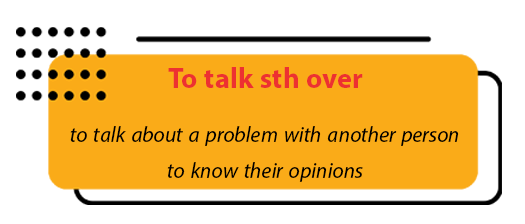
To sort something out
This item is also of problem solving phrasal verbs . When you say “ sort something out ” you mean to successfully solve a problem. For example:
- “my laptop has a problem and I have to sort it out .”
It means, I have to try to solve my laptop’s problem. Or look at this example:
- “We had a productive meeting, I felt we sorted out a lot of problems.”
It means, the meeting was so good that during the meeting we sorted out (we solved) the problems and we found good solutions.

To deal with something or somebody
We use “to deal with something or to deal with somebody “ when we have a problem with somebody or something and we want to solve a problem .
Imagine you are in a very difficult situation, but you have to deal with it . It means, the situation is really difficult , but you have to try hard and solve the problem . You can also use it to talk about people with whom you have an issue. For Example:
- “Don’t worry about Jake. I will deal with him myself.”
It means, maybe Jake is going to get angry over what you are going to tell him. But don’t worry, I will deal with him.

Read more: Learn about the most common argument phrasal verbs in English
To iron out
Imagine you have a wrinkled shirt, and you want to make it smooth and nice. When we say “iron out,” it’s like saying, “Let’s fix the wrinkles and make things nice and straight.”
In everyday life, “iron out” is a phrase we use when we want to fix or make something better. It’s like smoothing out problems or difficulties, just like you would smooth out the wrinkles in a shirt with an iron.
For example, if there are disagreements or issues in a plan, you might say, “Let’s talk and iron out the details,” meaning let’s fix any problems or make things clearer.
So, “iron out” is like saying, “Let’s make things smoother and better by working together and fixing any bumps in the road.” It’s a bit like being a problem-solving superhero, making everything nice and tidy!
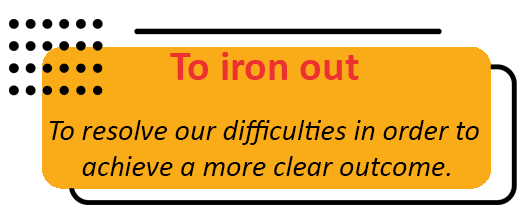
To face up to something
“To face up to something” is a very common and useful phrasal verb. Attention, this phrasal verb has two prepositions:
When you say “to face up to a problem” or a problematic situation, you mean to accept that there is a problem . You know, most of the time when there is a problem with us or in our lives, we tend to ignore it to say that there is not a big problem.
We try to ignore and avoid problems. But sometimes at some point, we have to face up to the problem, which means we have to accept that there is something wrong . For example:
- “She has to face up to the fact that her husband is guilty.”
Now, imagine a wife whose husband is guilty, and she doesn’t want to accept the fact that he’s guilty.
At some point, the police might say “listen ma’am, you have to face up to the fact that your husband is guilty” . It means, you have to accept it. Or let’s take a look at another example:
- “They will never offer you another job. You might as well face up to it.”
It means, you have to accept the fact that they are not going to offer you a new job.

To come up with something: Of problem solving phrasal verbs
“To come up with something “ is another handy phrasal verb to talk about problems and solutions. Now listen up, this phrasal verb has two prepositions:
To come up with an idea or to come up with a solution means to think of an idea or to think of a solution . For example:
- “We have been asked to come up with some new ideas.”
It means they have asked us to think of something new and to propose the new ideas to them. Or let’s take a look at another example:
- “Is that the best you can do? You have to come up with a better solution.”
It means, I’m sure you can do something better. Now, your solution is terrible! You have to come up with a new solution.

To hammer out
Imagine you have a big block of clay, and you and your friend want to turn it into something cool, like a sculpture. When we say “hammer out,” it’s like saying, “Let’s shape and mold this clay by working on it together.”
In everyday life, “hammer out” is a phrase we use when people need to work together to figure things out or make decisions. It’s like using a tool, like a hammer, to shape and create something. Instead of a real hammer, we use talking and discussions to shape ideas and plans.
For example, if a group of people has different opinions and needs to agree on something, they might say, “Let’s sit down and hammer out a solution,” meaning let’s talk and work together until we find an answer everyone is happy with.
So, “hammer out” is like saying, “Let’s work together, talk it through, and shape our ideas until we come up with a good plan or decision.” It’s a bit like being a teamwork artist, creating something awesome together!

To narrow something down
Sometimes, when you are trying to deal with a problem, you might take a piece of paper, grab a pen and start writing down the solutions that come to mind.
There may be hundreds of solutions on your list and you don’t know which one is better than the other one. Confusing. Right?
You cannot solve the problem unless you start narrowing down the solutions.
But what does it mean when you say “to narrow something down”?
It means to try to make the list of things smaller and smaller by crossing out the unnecessary or the worst options on the list. You start narrowing the list down to a few very good solutions.
- Imagine your boss has asked you to come up with a couple of possible solutions to a problem. You make a list of 20 solutions, you go to your boss’s office and say: “I have a list of 20 possible solutions.” Your boss says: “20? That’s a lot. You have to narrow the list down to less than five.”
It means you have to cross out 15 possible solutions and give me five very good ones. Or let’s take a look at another example:
- “That is quite a long list, you have to narrow it down .”

So far, we’ve learned six English phrasal verbs that you can use to talk about problems or solutions.
Read more: make a decision phrasal verb
How to use problem solving phrases and phrasal verbs?

“Yesterday my boss asked me to move to a new department which was in another city. Well, as a married man, I had to talk it over with my wife to see if we could sort it out somehow. When I told my wife about it, she said that “ You have to deal with it yourself! I don’t want to move to a new city. I have a job here. I have friends and I have a family. I can’t leave them all behind. “ So, I came up with a long list of possible things we could do, and started crossing out the bad ones. In the end, I narrowed it down to two options; either to quit my job or leave without my wife! I had two terrible options. Fortunately, my wife realized that I was also her family, and she faced up to this issue and agreed to come with me!”
In this story, I have used all six problem and solution phrasal verbs.
Let’s learn about more problem solving phrases.
To move on: Of problem solving phrases
Let’s imagine that you’re friend is going through a breakup with his girlfriend. What would you suggest him to do? You can advise him to move on! “To move on” means to go ahead and leave the past behind you and focus on the future . For example:
- Hey, what’s the matter?
- I saw Jessica with another guy!
- Well, you broke up with her, didn’t you?
- Yeah, I did, but…..
- There’s no but! You need to move on!

To nail down
Imagine you have a bunch of colorful balloons, and you want to tie them down to a weight so they don’t fly away. When we say “nail down,” it’s like saying, “Let’s make sure something is secure and won’t move.”
In everyday life, “nail down” is a phrase we use when we want to make something definite or certain, just like tying balloons so they won’t float away. It’s like saying, “Let’s figure out exactly what we mean or what needs to be done.”
For example, if you and your friends are planning a party and you’re deciding on the date, you might say, “Let’s nail down the date,” meaning let’s decide on a specific date so everyone knows when the party will be.
So, “nail down” is like saying, “Let’s make it clear and certain, like nailing something in place so it doesn’t move around.” It’s a bit like being a planner, making sure everything is set and secure!
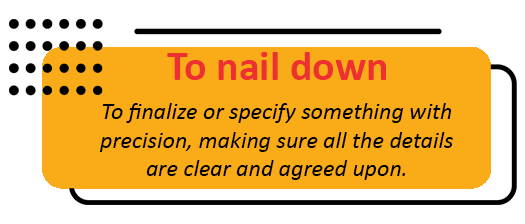

To get over something: Of problem solving phrases
Another thing you can ask him to do is to get over it! “To get over something” means to forget about something, to accept it and leave it in the past. For instance:
- I can’t believe I saw Jessica with another guy!
- Come on! Get over it, she’s not your girlfriend anymore!

Talking about problems in English: To let it go
Another thing you can ask your friend to do is to let it go! “To let go of something” means to leave something go, to forget about it and make a new start.
- You know what? It was Jessica’s fault that we broke up!
- Oh, for crying out loud, would you let it go?!

To patch up
Imagine you have a favorite stuffed animal, and it gets a little tear. When we say “patch up,” it’s like saying, “Let’s fix and mend that tear so it’s as good as new.”
In everyday life, “patch up” is a phrase we use when we want to repair or mend something, like a friendship or a relationship. It’s like saying, “Let’s work together to make things right again.”
For example, if you and a friend had an argument, you might say, “Let’s talk and patch up our friendship,” meaning let’s have a conversation to fix any problems and make things good between us again.
So, “patch up” is like saying, “Let’s mend and fix things, like patching up a torn favorite toy or making up after a disagreement.” It’s a bit like being a repair person for feelings and relationships!
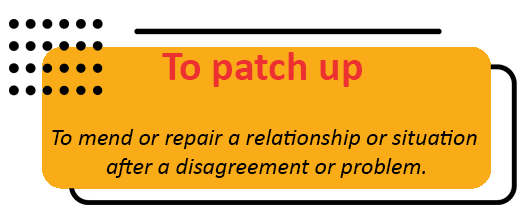
To leave it all behind: Of problem solving phrases
Another thing you can ask your friend who is dealing with a problem to do is to leave it all behind. It means to start from scratch, to go back to square one, and to create a whole fresh start.
I still can’t believe it! I mean what does Jessica see in that guy anyway?
- Oh, God! You have to leave it all behind and focus on your future!

Talking about problems in English: To make a new start
The last thing you can ask your friend to do is to make a new start. “To make a new” start means to start from scratch, to go back to square one, and to create a whole fresh start.
- I don’t know what to do after Jessica!
- You need to forget about her and make a new start!
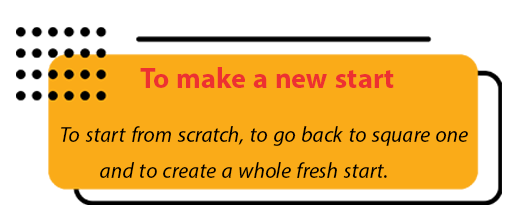
Watch this video about problem solving phrases in English
Summery of the lesson: Problem solving phrases and phrasal verbs
✅ work out → To successfully resolve or find a solution to a problem or challenge
✅ talk it over → To talk about a problem with another person to know their opinions
✅ sort it out → To successfully solve a problem
✅ deal with it → To try to solve a problem
✅ iron out → To resolve or smooth out difficulties or disagreements in order to achieve a more harmonious or clear outcome.
✅ come up with → T o accept that there is a problem
✅ hammer out with → To discuss and negotiate in order to reach a final agreement or solution
✅ narrow the list down → T o think of an idea / a solution
✅ face up to → T o make the list of things smaller and smaller by crossing out the unnecessary options
✅ To move on → To go ahead and leave the past behind you and focus on the future
✅ To nail down → To finalize or specify something with precision, making sure all the details are clear and agreed upon
✅ To get over something → To forget about something, to accept it and leave it in the past.
✅ To let it go → To leave something go, to forget about it and make a new start.
✅ To patch up → To mend or repair a relationship or situation after a disagreement or problem.
✅ To leave it all behind → To start from scratch, to go back to square one, and to create a whole fresh start.
✅ To make a new start → To start from scratch, to go back to square one, and to create a whole fresh start.
Don’t forget to practice all the six problem and solution phrasal verbs! See you in the next lesson!
If you want to learn about more phrasal verbs in English and generally improve your English level, join my online English course .Take this course and level up your speaking, writing, and reading skills.
Looking to improve your IELTS scores? The POC English online IELTS course can help you prepare for the exam with convenience and flexibility. Take this course and get a great score with the help of teacher Maddy.
related post

Asking for and giving advice in English + video

Job interview conversation in English + video

English phrasal verbs: Studying & Exams + video

I think synonyms : formal and informal + video
23 Comments

More than 10 change synonyms + idioms for change

Silent letters in English + examples + video

Physical appearance vocabulary | Phrases & idioms

Other words for but | but synonyms + video
5 thoughts on “ 16 problem solving phrases with example + video ”.
Hello Very useful for me you send me voice same with this email and send for me nesseriy vocabulary for Ielts Thanks a lot
I like the lesson which I have received and I enjoy it, it useful to me thanks.
Splendid explanationu
wow Teacher you are a very kind and excellent
Hello friends, how is all, and what you would like to say about this post, in my view its in fact remarkable in support of me.
Leave a Reply Cancel reply
Your email address will not be published. Required fields are marked *
Save my name, email, and website in this browser for the next time I comment.
An Artificial Intelligent English Learning Platform
5 Top Idioms For Problems
English Idioms for Problems, expressions, and proverbs are an important part of the English language, both spoken and written English are saturated with them.
For English Learners idioms are confusing to understand, the reason being Idioms don’t make common sense.
To learn the meanings and usage of idioms, English students must practice and familiarize themselves with their everyday usage.
The team at Lillypad understands the pain and difficulties English Learners confront comprehending the true meaning and accurate usage. This idioms list of Problems makes learning painless, with common Problems idioms, definitions, and example sentences that make the meaning clear.
Learning to use common idioms and expressions will make your English sound more native, so it’s a good idea to master some of these expressions with daily practice, so bookmark this page or share it with your friends; now let us learn about idioms for Problems together.
Idioms for Problems with Meanings, Definitions & Example Sentences
1. the last straw, definition and meaning: the last straw.
The expression “the last straw” is used to describe a situation where someone has had enough and can’t take anymore.
The Last Straw Example Sentences:
- After my boss yelled at me for the third time this week, the last straw was when he made me stay late to finish a project.
- After months of dealing with my roommate’s messiness, the last straw was when I found mold growing in the kitchen.
- After my car broke down for the third time this year, the last straw was when I had to pay for a costly repair.
- After my partner’s constant criticism, the last straw was when they belittled me in front of my friends.
- After my child’s poor grades, the last straw was when they were suspended from school.
2. I’m Not Putting Up With This!
Definition and meaning: i’m not putting up with this.
This expression means that the speaker is not going to tolerate a certain situation.
I’m Not Putting Up With This! Example Sentences:
- I’m not putting up with this! I’m not going to let you talk to me like that!
- I’m not putting up with this! I’m not going to let you take advantage of me any longer!
- I’m not putting up with this! I’m not going to let you keep making excuses for why you can’t do your job!
- I’m not putting up with this! I’m not going to let you keep ignoring my requests!
- I’m not putting up with this! I’m not going to let you keep disrespecting me!
3. I’ve Had It Up To Here!
Definition and meaning: i’ve had it up to here.
The expression “I’ve had it up to here!” is used to describe frustration or anger.
I’ve Had It Up To Here! Example Sentences:
- I’ve had it up to here with my boss’s unreasonable demands!
- I’ve had it up to here with my neighbor’s loud music late at night!
- I’ve had it up to here with my kids fighting all the time!
- I’ve had it up to here with my partner’s lack of communication!
- I’ve had it up to here with my co-workers gossiping about me!
4. Getting On My Nerves
Definition and meaning: getting on my nerves.
The expression “getting on my nerves” is used to describe someone or something that is causing annoyance or frustration.
Getting On My Nerves Example Sentences:
- His constant complaining is really getting on my nerves.
- Her loud music is getting on my nerves.
- His constant interruptions are getting on my nerves.
- His constant nagging is getting on my nerves.
- His constant texting is getting on my nerves.
5. At The End Of My Rope
Definition and meaning: at the end of my rope.
The expression “at the end of my rope” means that I am out of options and have no other recourse.
At The End Of My Rope Example Sentences:
- I’m feeling so overwhelmed with all of my responsibilities that I’m at the end of my rope.
- I’ve been trying to fix this problem for hours and I’m at the end of my rope.
- I’m so exhausted from all of the stress that I’m at the end of my rope.
- I’ve been searching for a solution to this issue for days and I’m at the end of my rope.
- I’ve been dealing with this issue for so long that I’m at the end of my rope.
Learn from History – Follow the Science – Listen to the Experts
What’s the one thing that makes LillyPad so special? Lilly! She is a personal English tutor, and has people talking all over the world! Lilly makes improving your English easy. With Lilly, you can read in four different ways, and you can read just about anything you love. And learning with Lilly, well that’s what you call liberating!
For learners of all ages striving to improve their English, LillyPad combines the most scientifically studied and recommended path to achieving English fluency and proficiency with today’s most brilliant technologies!
Additionally, the platform incorporates goal-setting capabilities, essential tracking & reporting, gamification, anywhere-anytime convenience, and significant cost savings compared to traditional tutoring methodologies.
At LillyPad , everything we do is focused on delivering a personalized journey that is meaningful and life-changing for our members. LillyPad isn’t just the next chapter in English learning…
…it’s a whole new story!
Do you want to improve your English? Visit www.lillypad.ai .
Follow us on Facebook or Instagram !
William Landry
William is a professional English and ESL teacher with over 15 years of experience. He has taught students of all ages, from children to business executives, and has worked with ESL learners from all over the globe. With a degree in English Education, William has developed curriculum for learners of all levels and interests. He is passionate about helping people learn English effectively and shares his knowledge with the LillyPad community. When he’s not teaching or writing, William enjoys spending time with his wife and two young children.
Related Articles
8 ways to improve your english by reading what you love with an ai tutor, how to read like a professional, what are the benefits of reading aloud, the world of online book clubs, improve your english faster with lilly an artificial intelligent tutor.
Latest Posts
Understanding YLTE: Importance of English Test for Young Learners
Top 10 errors in english proficiency tests & how to avoid them, challenges in english proficiency tests for language learners.
FLUOROSCOPE LANGUAGE CALCULATOR
How long will it take you to improve your English?
Design, write and practice your own phrases or learn 3,500+ premade English phrases with Lilly!
© 2023 LillyPad.Ai
Type your email…
Talking about Problems in English
Published by my lingua academy on 12 dec 2021 12 dec 2021.
We all know what the problem is. It is a more or less difficult situation that is causing us inconvenience and stopping us from doing what we want. Here are different ways for talking about problems in English, including collocations, idioms, phrasal verbs, synonyms, and conversation questions to help you remember the new vocabulary.
Collocations related to problems
Face/encounter/confront a problem.
If you face or encounter or confront a problem, then you are aware of it and you are trying to deal with it.
For example:
- Today, we are facing global warming issues that must be dealt with as soon as possible.
- When they tried to deal with the problem of discipline in their school, they encountered the problem of drugs abuse.
- The Johnsons have been confronted with many problems since they moved to another country.
Address/tackle the problem
If you address or tackle a problem, you are trying to solve it.
- The member of the parliament addressed the problem of human rights in the last night’s TV programme.
- The United Nations and governments of countries all around the world are trying to tackle environmental problems.
Deal with a problem
If you are dealing with a problem, you are taking concrete actions in order to solve it.
- Right now, our company is dealing with a problem of safety at work.
- The police have a strategy for dealing with the problem of street riots.
Discuss/debate a problem
To discuss or debate a problem means to exchange your opinions and ideas with another person or a group of people.
- The residents of the building discussed littering in the neighbourhood.
- One of the most debated problems nowadays is protection against the Coronavirus.
Overcome a problem
If you overcome a problem, you succeed in dealing with it.
- He’ll get seriously ill unless he overcomes his problem of overeating.
- A way to overcome problems associated with online bullying is to avoid contact with strangers.
The root of the problem
This expression refers to the basic cause of a problem.
- I believe that the root of the problem lies in his shyness.
- The government is supposed to fight against the root of the problem, not the consequences.
Problem-solving
A compound noun related to the process of finding a solution to a problem.
- This course trains people in problem-solving in different situations.
- For this position, they expect their new employee to possess good problem-solving skills.

Other ways to talk about a problem
a small difficulty.
- The job in the advert looked perfect except for the hitch of a low salary.
a similar word to hitch. It refers to a small problem or disadvantage.
- The only snag to marriage is that you lose your freedom.
another way to say problem.
- Maria works with children with learning difficulties.
a problem that people are discussing.
- The scientists met to discuss environmental issues.
an obstacle that stops something from developing.
- Dorothy has been recovering from her illness successfully except for some small setbacks.
Complication
when the situation becomes more difficult than it was.
- The risk of complications occurring due to side effects is reduced.
when something stands in the way of achieving something.
- There are so many administrative obstacles that prevent workers from doing their job effectively.
a problematic or distressful situation.
- They had a lot of trouble with that Ikea cupboard. The parts just didn’t fit in.
a difficult task that may be interesting because it tests your skills and abilities.
- The Olympic basketball team is ready to face the challenges of the competition.

Phrasal verbs related to problems
to take necessary action in order to solve a problem.
- We must deal with this problem now before it becomes bigger.
- You have to learn how to deal with all kinds of problems if you want to progress in life.
to experience a problem unexpectedly.
- The company ran into some serious financial problems and bankrupted in a year.
- if you run into difficulties while operating this machine, call the mechanic immediately.
Run up against
when you have to deal with an unexpected problem.
- After they launched the new product, they ran up against some unexpected problems.
- When Lorna tried to talk to her husband about the problem she ran up against silence.
Knuckle down
to begin to work on something in order to solve a problem.
- The police knuckled down to the task of investigating the details of the robbery.
- If we knuckle down really hard, we’ll have this presentation ready by the end of next week.
Wrestle with ( a problem)
to try hard to deal with a problem or reach a difficult decision.
- Sam had a hard time wrestling with the problems in her marriage – should she divorce or not?
- Sara spent most of the afternoon wrestling with her Math homework.
Talk something over
to discuss a problem with someone before making a final decision.
- First I need to talk it over with my husband and if we decide to buy a house, we’ll contact you.
- If you have digestion problems, you should talk it over with your doctor.

Idioms about problems
Be in dire straits.
a very difficult financial situation.
- They met after the war when the country was in serious financial dire straits.
- The company is facing dire straits so they’re going to borrow some money from a bank.
Vicious circle
when one problem causes another, which creates even more difficulties.
- People on reduction diets often fall into a vicious circle of losing and then gaining weight again.
- I wish the vicious circle of poverty and stagnation ends in the world.
Put your foot in it
to say something accidentally so that it causes embarrassment and distress.
- I don’t like her at all. Oh sorry, did I put my foot in it? She’s your friend, isn’t she?
- Paul was quick to end the conversation before he put his foot in it even more.
Come up against a (brick) wall
to get to a point when you can not go on because something is preventing you from progressing.
- Many students come up against a brick wall when they apply for scholarships.
- Fiona was working long hours all last week. She’d stopped only when she felt that she came up against a brick wall and couldn’t think clearly.
Fall into place
when things happen without much difficulty.
- Once I organized my work well, everything fell into place so I had plenty of time for my leisure activities.
- After an extremely complicated plot, everything fell into place at the end of the film.
The light at the end of the tunnel
a ray of hope after a period of worry and difficulties.
- When the vaccine against the Coronavirus was invented, humankind could finally see the light at the end of the tunnel.
- We managed to solve some really serious problems within the company and now we can finally see the light at the end of the tunnel.

Conversation questions for talking about problems in English
The best way to remember new vocabulary is to use it immediately. Therefore, try to discuss these questions with your English speaking partner:
- What is the greatest challenge/problem you have faced at school or work so far? How did you overcome it?
- Have you ever come up against a brick wall? When and what happened?
- Do you deal with your problems by yourself or do you discuss them with someone? Who?
- Have you ever got embarrassed by putting your foot in it?
- Who do you usually discuss your problems with? Asking for advice?
- Have you ever helped anyone solve their problem? Did they take your advice?
- Do you think the problem of global warming will be solved in this century?
- Do you think the problem of discrimination will stop existing in this century? Why/Why not?
- Do you think the problem of poverty and financial difficulties will be solved in this century? Why? Why not?
- How can social issues affect society?

Let me take your English to the next level. If you feel that you are not making much progress with your English or as quickly as your academic or professional requirements demand, how about trying my reasonably-priced one-to-one English lessons that I can tailor to whatever needs you may have like sitting forthcoming English certification exams, or taking part in business meetings with your international colleagues, or passing your job interview in English. Book an online English lesson with me or one of my fellow certified and experienced English teachers, and see for yourself. You won’t feel let down because we are going to make sure that you have a good run for the money you are investing in your linguistic education. Waste no time and take a trial test for only 1 euro.
Share this:
- Click to share on Twitter (Opens in new window)
- Click to share on Facebook (Opens in new window)
- Click to share on LinkedIn (Opens in new window)
- Click to share on Tumblr (Opens in new window)
- Click to share on Pinterest (Opens in new window)
- Click to email a link to a friend (Opens in new window)
- Click to print (Opens in new window)
- Click to share on Reddit (Opens in new window)
- Click to share on WhatsApp (Opens in new window)
My Lingua Academy
My Lingua Academy is an online school of English language. We give one-on-one lessons to students of English of all ages and all levels of knowledge all around the world. With us you can prepare for written assignments and exams, attend a general or business English course, or have conversation classes with qualified English teachers who have years of experience.
Leave a Reply Cancel reply
Related posts.

Articles Collocations Idioms & Expressions Phrasal Verbs Vocabulary
32 ways to use the verb pay.
Hi dear English learners! Have you paid a compliment to someone recently? If you want to find out what this expression means, keep on reading. Today, we will be learning collocations, phrasal verbs and idioms using the verb PAY. This verb usually has to do with money, but not necessarily. We can use it in collocations such as pay attention or pay a visit, which have nothing to do with money or paying. So, let’s learn 32 different ways to use the verb pay.

Articles Synonyms Useful Phrases Vocabulary Writing
Words and phrases to use instead of therefore.
Hi dear English learners. Here is another lesson where you can learn different ways to say therefore. In case you are writing an essay or are involved in business correspondence quite often, you probably need to know all these words in order to make your writing more interesting, diverse and eloquent. Here are 10 words and phrases to use instead of therefore.

Articles Grammar Useful Phrases Vocabulary Writing
How to use even.
dear English learners. Here we are again with a new lesson. Today's lesson is about the adverb even. We are going to learn how to use even in a sentence with lots of examples so you can learn about it in context. We normally use even to emphasize something unusual or surprising.
Discover more from My Lingua Academy
Subscribe now to keep reading and get access to the full archive.
Continue reading

Idioms in Figurative Language with Examples and Activities
The idea for this blog post all started when I was in the car with my 4-year-old twins and asking them what they wanted in their premade dinner snack box because we had swimming lessons that night so I like to give them a little pre-dinner meal in the car so they can make it until actual dinner after swimming lessons.
First, I asked one twin and he told me what he wanted. I then moved on to the other twin asking him what he wanted to eat, however, he was fully engulfed in play in his car seat and didn’t hear my question. I then proceeded to say, “Earth to Boden”. Both boys thought that was such a weird comment to make. Was I trying to send Boden to earth? But he was already on earth…right?
I then went on to explain that it is an expression meaning, “Hello, are you paying attention?” They both laughed and said, “oh!”
This sweet little moment with my boys got me thinking about idioms and just how confusing they can be. So I decided I’d bring to you a quick guide to idioms and figurative language as well as 10 common examples with a free idiom activity for your child or students.

Idioms and Figurative Language: A Comprehensive Guide
Idioms are figurative expressions that are common in everyday speech in the English language. As a form of figurative language, idioms use words in an imaginative manner to convey non-literal meanings that are not immediately obvious from the literal interpretation of the words.
Understanding figurative language is important for effective communication in English, as it can convey complex ideas and emotions in a concise and memorable way. Idiomatic expressions are just one type of figurative language, but they are common and can be found in many different contexts, from everyday conversations to literature.
Enhancing figurative language skills can be challenging, as it requires a deep understanding of the English language and the ability to use words creatively.
However, by learning about the different types of figurative language and practicing their use in everyday conversations, you can help your students become more confident and effective in their communication!
We have gathered 10 common idiom videos and have created a fun free activity to go along with them below.
Key Takeaways
- Idioms are a form of figurative language that use words in an imaginative manner to convey a meaning that is not immediately obvious from the literal interpretation of the words.
- Figurative language is important for effective communication in English, as it can convey complex ideas and emotions in a concise and memorable way.
- Enhancing your figurative language skills can be challenging, but by learning about the different types of figurative language and practicing their use in everyday conversations, you can become more confident and effective in your communication.
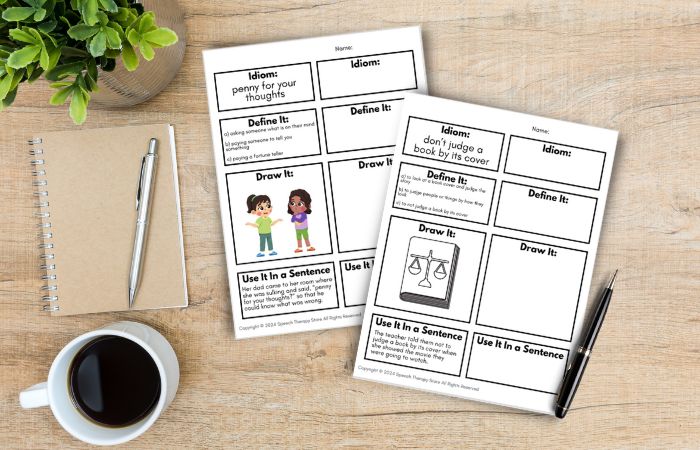
Understanding Figurative Language
Figurative language is the use of words or expressions that convey a non-literal meaning, often to create a more vivid or impactful image in the mind of the listener or reader.
It goes beyond its literal meaning to convey a more abstract or symbolic idea.
This can include the use of metaphors, similes, idioms, and other types of figurative expressions.
Distinguishing Literal from Figurative
- Literal Expressions – the straightforward, dictionary meaning of words or a phrase.
Example: “give a cold shoulder” would mean to actually give some a shoulder that is frozen.
- Figurative Meaning – the listener has to interpret the non-literal meaning based on context, cultural knowledge and personal experiences.
Example: “give a cold shoulder” has different meanings in the English language, and is a type of idiomatic expression that means to purposefully be rude or unfriendly to someone.
Understanding figurative language in everyday speech is an essential aspect of effective communication. It is a powerful tool that allows us to convey complex ideas and emotions in a more engaging and memorable way, and can help to create a deeper connection with the listener or reader.

Types of Figurative Language
There are several types of figurative language that writers use to convey powerful messages in a creative way. These tools of expression are often used to add depth and meaning to the text.
Here are some of the most commonly used types of figurative language!
Similes and Metaphors are used for comparison.
- Simile – Uses “like” or “as” to compare two things that are not alike.
Example: Her eyes are as blue as the sky.
- Metaphors – Directly compares two things without using “like” or “as”.
Example: Life is a journey.
Idioms and Proverbs are used to convey human characteristics and emotions.
- Idiom – A phrase or expression that has a figurative meaning that is different than its literal meaning.
Example – I can put that together it’s a piece of cake.
- Proverb – Is a short saying that is used to convey a moral or lesson.
Example – You can’t teach an old dog new tricks.
Hyperbole and Understatement are opposite figures of speech.
- Hyperbole – Is an exaggeration used to emphasize a point.
Example: I told you a million times.
- Understatement – Downplays the importance of something.
Example: It’s just a scratch.
Personification and Anthropomorphism are two examples of figurative language that give human characteristics to non-human things.
- Personification – Is when a non-human object, animal, or thing is described with human characteristics.
Example: The alarm clock yelled.
- Anthropomorphism – Is when a non-human object, animal, or thing behaves like a human.
Example: The wind whispered through the trees.

Challenges in Figurative Language
Understanding idioms and figurative expressions can be challenging for many individuals, including non-native English speakers and those with language disorders.
For Non-Native Speakers
Non-native English speakers may struggle to understand idioms and figurative language due to the different meanings these expressions can have. Idioms often have non-literal meanings that are not immediately apparent from the words used.
Another challenge for non-native speakers is the cultural understanding or understandings of the origins of the phrase required to grasp the meaning of common idioms.
Idioms are often rooted in cultural references that may not be familiar to those from different backgrounds.
For Individuals with Language Disorders
Individuals with language disorders may also struggle to understand idioms and figurative language. These individuals may have difficulty processing the metaphorical meanings of idioms and may interpret them literally.
For example, someone with a language disorder may interpret the idiom “hold your horses” as a literal instruction to hold onto a horse.
Another challenge for individuals with language disorders is the difficulty in understanding the context in which idioms are used. Idioms often rely on context to convey their meaning, and individuals with language disorders may have difficulty understanding this context.
For example, the idiom “the cat’s out of the bag” means that a secret has been revealed, but this meaning may not be clear to someone who is not familiar with the situation in which the idiom is used.
SEE ALSO: 31 Best Wordless Videos to Teach Problem Solving
Idioms in the english language.
Idioms are a type of figurative language that native English speakers use every day. They are phrases that have a meaning different from the literal interpretation of the words. Idiomatic expressions are an essential part of the English language, and they add color and depth to everyday conversation.
Common Idioms and Their Meanings
English has a vast collection of idiomatic expressions that are used every day by native speakers. Each idiom has its meaning, and it is essential to understand the context in which it is used to comprehend its meaning.
Origins and Evolution
Idioms have been a part of the English language for centuries, and their origins can be traced back to cultural metaphors. Many idioms have their roots in literature, mythology, and historical events.
For example, the idiom “barking up the wrong tree” has its origins in hunting, where dogs would bark up the wrong tree, indicating that they were chasing the wrong prey. Over time, the meaning of idioms can change, and new idioms can emerge.
Regional Variations
Idioms can vary from region to region, and even from country to country. For example, the idiom “take a rain check” is commonly used in North America to mean that someone cannot accept an invitation but would like to do so at a later time.
In the UK, the equivalent idiom is “take a ticket for the next bus.” Understanding regional variations in idiomatic expressions can help non-native speakers communicate more effectively with native speakers.
SEE ALSO: 71+ Free Social Problem-Solving Scenarios

Enhancing Figurative Language Skills
To improve our figurative language skills, we need to learn and practice strategies that can help us understand and use idioms in our daily communication.
Learning and Practice Strategies
One of the best ways to learn idioms is through practice exercises. Below we have created a free idiom activity that can help your students learn and understand the meaning of idioms. Other exercises can be in the form of quizzes, games, or worksheets, and can be a fun way to learn new idioms.
Another great way to practice idioms is through video examples, which we have compiled below.
A great way to enhance our figurative language skills is by using context clues. Context clues are the words or phrases surrounding an unfamiliar idiom that can help us understand its meaning. By analyzing the context, we can decipher the meaning of the idiom and use it in our communication.
Contextual Understanding and Usage
To use idioms effectively, we need to understand the meaning of the words that make up the idiom. By understanding the word meanings, we can use idioms in the right context and convey our message effectively. We can also group idioms together based on their meaning and use them in social groups.
SEE ALSO: Problem Solving Wheel: Help Kids Solve Their Own Problems

10 Common Idiom Examples with Video Explanations
We have compiled 10 idiomatic expressions that are common in the english language. Use the one minute short videos, by @TomsTalkingELA, as a way to explain these figurative expressions in further detail.
These videos are powerful tools to explain the meaning of words, the origins of the phrase, the idioms non-literal meanings, and examples of how to use these common idioms in everyday speech.
Don’t forget to download our free common idiom exercise activity below!
Breaking the Ice
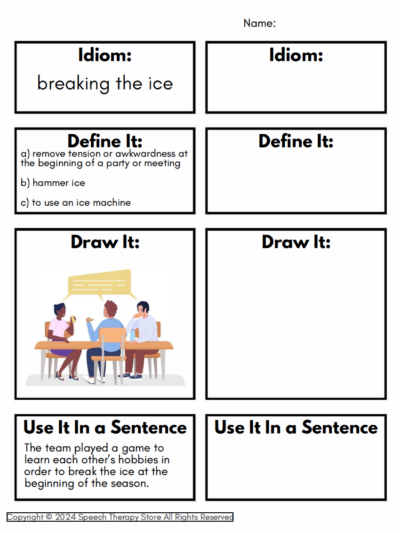
Back to the Drawing Board

To Be All Ears
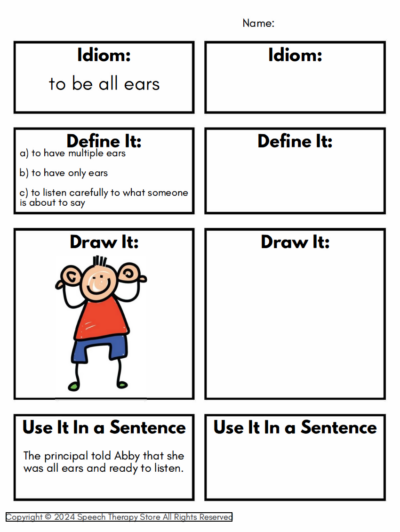
Cutting Corners

Eating your Words
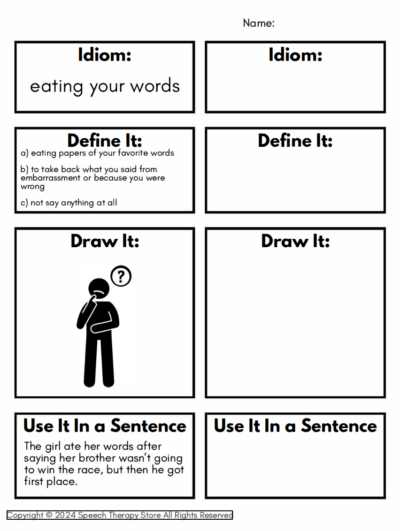
Under the Weather

Judge a Book by its Cover

Crying over Spilled Milk
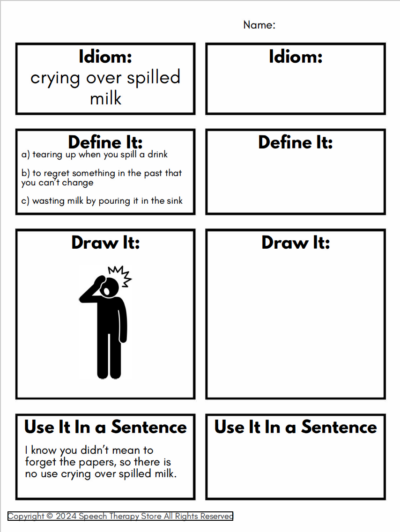
Break a Leg

Penny for your Thoughts
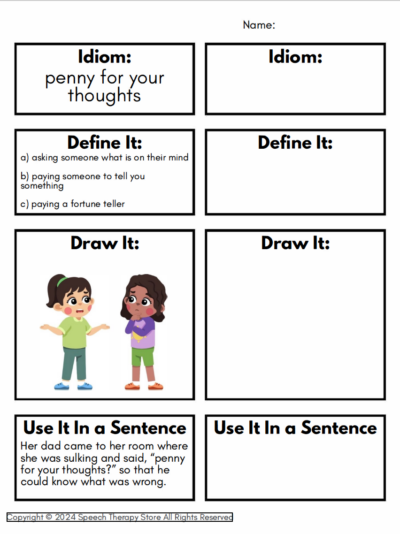
Idioms and figurative expressions can be challenging but are an effective way to communicate with peers and in different social groups.
We hope this quick explanation, as well as videos and activities to teach commonly used idioms, was helpful for you! Be sure to grab the 10 Commonly Used Idioms Activity. This is a free preview of our 100 Common Idioms + Quizzes Bundle!
Grab Your Free 10 Commonly Used Idioms Activity Here!
Simply enter your name and email to have this free 10 Idiom Activity emailed directly to your inbox!
Grab Your Idioms in Figurative Language Free Activity
Buy the complete 100 commonly used idioms activity here, frequently asked questions, what are examples of idioms and their meanings.
Idioms are expressions that convey a figurative meaning different from the literal meaning of the words used. Examples of idioms and their meanings include “kick the bucket” which means to die, “at the drop of a hat” which means to do something right away, “break a leg” which means good luck, “raining cats and dogs” which means heavy rain.
How does figurative language enhance communication?
Figurative language enhances communication by adding depth, color, and creativity to speech and writing. It helps convey emotions, experiences, and ideas in a way that is more interesting, memorable, and engaging than literal language. Figurative language can also help build rapport, establish trust, and create a sense of connection between the speaker and the listener.
Can you list different types of figurative language with definitions?
There are many types of figurative language, including:
- Simile: A comparison between two unlike things using “like” or “as.” Example: “She sings like an angel.”
- Metaphor: A comparison between two unlike things without using “like” or “as.” Example: “Life is a journey.”
- Personification: Giving human qualities to non-human things. Example: “The wind whispered in my ear.”
- Hyperbole: Exaggerating for effect. Example: “I’ve told you a million times.”
- Alliteration: Repeating the same sound at the beginning of words. Example: “Peter Piper picked a peck of pickled peppers.”
What distinguishes literal from figurative language?
Literal language refers to the use of words in their usual or most basic sense, while figurative language refers to the use of words in a non-literal or imaginative way. Literal language is straightforward and factual, while figurative language is more expressive, creative, and subjective.
How can figurative language be effectively used in speech therapy?
Figurative language can be effectively used in speech therapy to help clients improve their language skills, especially in areas such as vocabulary, comprehension, and social communication. By teaching clients to identify and use figurative language, speech therapists can help them become more effective communicators and better able to navigate social situations.
What role does alliteration play in figurative language?
Alliteration is a type of figurative language that involves the repetition of the same sound at the beginning of words. It is often used in poetry, slogans, and advertising to create a memorable and catchy effect. Alliteration can also be used to emphasize certain words or ideas, and to create a sense of rhythm and flow in speech and writing.
Want Even More Lesson Plans for Speech Therapy?
- Free SLP Planner [Updated Yearly]
- 917+ Best Free Boom Cards for Speech Therapy
- 31 Best Wordless Videos to Teach Problem Solving
- 133+ Categories List for Speech Therapy
- The Best Handout for Phonological Processing Disorder Therapy
Want the Best of the Bests?
Be sure to check out our most popular posts below!
- 21 Best Reinforcement Games for Speech Therapy / Teletherapy
- Best IEP Resources
- 71+ Free Social Problem-Solving Scenarios
- 430+ Free Multisyllabic Words List Activity Bundle
- 432+ Free Measurable IEP Goals and Objectives Bank
- 279+ Free Speech Therapy Digital Materials
- 179+ Free Speech Therapy Wh-Questions Printable
100 Best Idioms About Teamwork
Idioms about teamwork are like secret codes that convey big ideas about cooperation, unity, and working together towards common goals. They remind us that when we join forces, amazing things can happen.
From “ two heads are better than one ” to “ many hands make light work ,” these expressions add color to our language and inspire us to pull together. So, let’s dive into the world of teamwork idioms and discover the magic they hold in bringing people together!
Table of Contents
Enhancing Team Collaboration
1. Two Heads Are Better Than One
This idiom emphasizes the advantage of collaborative thinking in a team setting. This idiom implies that when individuals combine their mental capabilities and expertise, they’re likely to come up with solutions that are more creative and effective than what one person could achieve alone.
In a teamwork context, it serves as a reminder that the collective insight of a group is invaluable for problem-solving and innovation. It encourages open dialogue and sharing of ideas, underlining the concept that collaboration can lead to better outcomes, as multiple perspectives can address various aspects of a problem that may not be apparent to just one person.
2. Many Hands Make Light Work
This is a well-known saying that underscores the power of teamwork in accomplishing tasks more efficiently. When tasks are divided among several people, the burden on each individual is reduced, making the overall objective easier to achieve.
It’s a call to action for team members to contribute their efforts, reinforcing the idea that collaborative endeavors not only make the work less overwhelming but also foster a sense of shared responsibility and community. In the workplace, this idiom is often used to motivate employees to pitch in and help each other, ensuring that projects are completed swiftly and with less stress on each team member.
3. Pull Together
This is an idiom that directly calls for unity and collaborative effort among team members, especially in times of difficulty or when facing a common challenge. It creates an image of a group of individuals exerting their strength in a coordinated effort, much like a team of horses pulling a heavy load.
The phrase implies that when people set aside individual agendas and focus on the group’s objectives, the combined force can achieve significant results. It’s a rallying cry for teamwork and concerted action, serving as a reminder that the collective power of a group is greater than the sum of its parts when everyone commits to working together.
4. Put Our Heads Together
This is a phrase that champions the spirit of collaboration. It evokes a scene where team members physically lean in close, combine their intellectual resources, and brainstorm to solve a complex problem or develop a creative strategy.
This idiom is particularly relevant in teamwork as it suggests that pooling knowledge and expertise leads to more comprehensive solutions than what one person could generate independently. It’s often used to encourage team members to engage in open discussions, share unique insights, and create a synergy where the creative process is amplified by the diverse contributions of each member.
5. On the Same Page
This suggests a harmonious understanding or agreement among team members, mirroring the image of several people reading and acknowledging the same content in a document. In terms of teamwork, this idiom highlights the importance of clear communication and common goals.
When everyone on the team is “ on the same page ,” they share a unified vision and approach to the tasks at hand, which can greatly enhance the efficiency and effectiveness of their collaborative efforts. It also implies the need for regular check-ins and discussions to ensure that all members continue to move forward with a collective understanding.
6. In the Same Boat
This is commonly used to denote a shared situation or fate among a group of people. From a teamwork perspective, this idiom implies that every team member is affected equally by the outcomes of the group’s efforts, whether those outcomes are successes or challenges.
It fosters a sense of empathy and solidarity, as it’s a reminder that everyone has a stake in the success of the team, and thus, it’s in everyone’s best interest to work cooperatively and support one another in achieving common objectives.
7. Row in the Same Direction
This communicates a vital principle for effective teamwork: alignment in action and purpose. It conjures the image of rowers in a boat who must synchronize their strokes to travel efficiently. Applied to team collaboration, this idiom underscores the significance of aligning individual efforts with the group’s goals.
When all team members are working cohesively toward the same end, the team can harness their collective effort to move forward with greater momentum, similar to how coordinated rowing propels a boat more powerfully through the water.
8. Bridge the Gap
This idiom speaks to the act of overcoming differences and drawing members of a team closer, whether through improved communication, understanding, or collaboration. In the context of teamwork, this idiom suggests finding ways to connect disparate ideas, reconcile varying skills, or address gaps in knowledge and experience, essentially creating metaphorical bridges that allow for smoother collaboration and teamwork.
It’s often used in situations where there is a need to integrate new team members, reconcile cultural differences, or enhance the overall cohesion of a diverse group.
9. Bring Something to the Table
This is about the individual contributions that each team member makes toward a common goal. It likens the team’s collective effort to a potluck dinner, where everyone brings a dish to share. This idiom emphasizes the value of each person’s unique skills, knowledge, and resources, which, when combined, can benefit the entire group.
It’s a call to action for team members not to hold back but to offer their strengths for the betterment of the team’s objectives, reinforcing the idea that diversity in skills and perspectives can enhance overall team performance.
10. Circle the Wagons
This harks back to the days of the Old West when travelers would form a protective circle with their wagons to guard against outside threats. In a modern teamwork context, this idiom takes on the meaning of coming together to protect and support one another in times of challenge or when facing external pressures.
It serves as a reminder that collective defense and mutual support are crucial for a team’s survival and success. When teams “ circle the wagons ,” they are showing unity and readiness to tackle difficulties by pooling their strengths and resources.
Leadership and Management
11. Steer the Ship
This is an idiom that denotes guiding a group or project in a particular direction, much like a captain controls a vessel’s course. In the realm of leadership and management, it underscores the responsibility of leaders to navigate the team through various challenges, making strategic decisions to keep the team on course towards their objectives.
This phrase often implies that the leader must be able to adapt to changing conditions, maintaining a clear vision and control, even when facing turbulent waters that may symbolize the complexities encountered in a team environment. It also reinforces the collaborative nature of teamwork, where the leader may steer, but it is the concerted effort of the entire crew that truly propels the ship forward.
12. Run a Tight Ship
This is a phrase that conveys the concept of managing a team or organization in an orderly and disciplined manner. It suggests that leaders enforce strict rules and maintain high standards to ensure that everything operates efficiently and effectively.
This idiom highlights the importance of structure and order within team management, where clear roles, responsibilities, and expectations are crucial to the team’s success. It also recognizes the balance a leader must strike between discipline and flexibility within a team, ensuring that while operations run smoothly, creativity and innovation are not stifled.
13. Captain of the Ship
“ Captain of the ship” clearly places a person in a leadership role within a team, suggesting they have the ultimate authority and responsibility for the team’s progress and welfare. This idiom speaks to the concept that, in teamwork, there’s a need for someone to take charge, set the direction, and inspire confidence in others.
The captain must not only command but also listen to the crew, fostering an environment of mutual trust and respect. As with a ship’s captain, effective leaders in a team must stay vigilant, be ready to face unforeseen challenges and make decisions that ensure the safety and success of the collective group.
14. Take the Bull by the Horns
This idiom conveys a proactive approach to leadership and management. It suggests that a person assertively confronts and takes control of a difficult situation rather than avoiding it or delaying action.
In a team setting, this idiom can be used to describe a leader who steps up to address challenges directly and leads the team through complex problems by example. It implies determination, decisiveness, and courage to face tough issues head-on, which can be motivating for team members who rely on their leader’s strength and clarity of purpose.
15. Call the Shots
This means making important decisions or dictating how something should be done. In the context of teamwork, it defines the role of a leader as the one who has the authority to make final decisions that the team follows.
An effective leader who “ calls the shots ” is one who thoroughly understands the team’s dynamic, capabilities, and goals and is therefore trusted to guide the team’s actions. However, it also carries the connotation that good leaders engage their teams in the decision-making process and leverage their collective expertise before taking those decisive shots.
16. Rally the Troops
This is a military term repurposed into common parlance that involves a leader inspiring others to come together and focus on a common goal.
In a team context, this idiom reflects a leader’s ability to energize and motivate team members, particularly in preparation for a major effort or when the team faces significant challenges. It is a call for unity, enthusiasm, and collective action, implying that when a team is fully rallied, their combined efforts can achieve remarkable results.
17. Hold the Fort
This describes the act of being in charge and maintaining operations in someone’s absence or during a challenging period. For a leader in a teamwork situation, this idiom suggests overseeing and securing the team’s progress, ensuring that goals are continuously met even when faced with potential disruptions.
Holding the fort requires resilience and a steady hand, signifying that the team leader is a reliable anchor who can maintain stability and keep team morale high under pressure.
18. Keep the Team on Track
This idiom suggests guiding and ensuring that everyone is focused and progressing toward the set goals. In a teamwork environment, it highlights the leader’s role in monitoring progress, providing guidance, and adjusting plans as necessary to avoid derailment.
This phrase captures the ongoing effort required to maintain a clear direction, emphasizing the importance of consistency in leadership to ensure that each team member understands their role and remains committed to the collective aims of the group.
19. Pilot the Project
This implies taking the lead on a specific initiative or task. Within a team, this idiom relates to the responsibility assumed by an individual (usually a leader or manager) to guide the project through to completion.
The term ‘ pilot ‘ suggests a test or trial run of a new idea or strategy, signifying that the leader is not afraid to venture into uncharted territory with the support of their team. It highlights both the experimental nature of managing new initiatives and the element of control and direction needed from the leader.
20. The Buck Stops Here
This originates from President Harry S. Truman and denotes accepting full responsibility for all decisions and their consequences. As a leadership idiom in the context of teamwork, it underscores the idea that a leader does not pass the blame onto others. Instead, they stand accountable for the team’s actions and outcomes, whether good or bad.
This phrase reinforces the expectations on leaders to take ownership over their decisions and to stand as responsible and principled figureheads for their teams, fostering an environment of trust and integrity within the group.
Building Team Spirit
21. Keep the Ball Rolling
This is an idiom that encourages sustained action and continued progress. Within a team, this phrase suggests that once an initiative or project has begun, it is vital to maintain momentum and make sure that tasks are being completed one after the other. This involves each team member actively contributing and staying engaged to prevent stagnation.
Leaders often use this phrase to motivate team members, emphasizing the importance of persistence and the collective effort needed to move towards a shared goal. It also suggests that each member’s input is like a push to the ball, giving it direction and speed, and when everyone pushes together, the ball rolls faster and more smoothly toward the end goal.
22. Pump Up the Team
This embodies the idea of energizing and motivating a group of people to enhance their performance. It is akin to inflating a tire or a ball – the process of injecting enthusiasm into the team, thereby increasing their readiness and vigor to tackle challenges.
This idiom recognizes the influence of positive morale on team productivity and the role of uplifting communication and team activities in creating a spirited and cohesive work environment. It’s a directive for leaders to inspire and embolden their teams, invigorating their spirit for collaboration and success.
23. Raise the Bar
This idiom implies setting higher standards or expectations to encourage improved performance and outcomes. This idiom is about challenging the team to exceed previous achievements and push the limits of their capabilities. It drives home the concept that continuous improvement is essential for a team’s growth and success.
Leaders who ‘ raise the bar ‘ are looking for ways to enhance team skills and productivity, fostering an environment where excellence is pursued and the status quo is not enough. It calls upon team members to aspire to greater heights and to support each other in this pursuit.
24. Bring Home the Bacon
This speaks to the successful achievement of objectives, often with the connotation that the team has secured a substantial reward or benefit, whether that be a contract, a sale, or project approval. This idiom derives from the notion that ‘ bacon ‘ is a valuable commodity, and delivering it home signifies providing for the group.
In terms of teamwork, accomplishing goals that benefit the team reinforces a sense of purpose and boosts collective morale. It commends the efforts of team members working together to secure victories that sustain and improve their common enterprise.
25. Go the Extra Mile
This means doing more than is expected or required and putting in additional effort to achieve superior results. This phrase encourages team members to go beyond their basic duties and to contribute to the team with exceptional dedication and commitment.
It’s a mindset that can lead to innovation and high-quality work and, ultimately, can set the team apart from competitors. It also implies that when everyone in a team is willing to ‘go the extra mile’, the cumulative effect of these extra efforts results in significant advancements and achievements for the team as a whole.
26. Pass the Torch
This expression is derived from the relay race, where a runner hands over the torch or baton to the next person. In the context of teamwork, this idiom illustrates the importance of knowledge transfer, leadership succession, and shared responsibilities.
It speaks to the essential aspect of sustainability within a team, ensuring that skills, values, and missions are continuously passed down so that the team’s performance endures even as individual members come and go. It reinforces the idea that each member has a contributing role and that team continuity is maintained through shared leadership and collaboration.
27. All for One and One for All
This is a phrase famously used by The Three Musketeers, which encapsulates the essence of collective effort and mutual support. It implies that the team acts as a single entity with everyone working towards the same goal (all for one), and in turn, each individual receives support and dedication from the entire group (one for all).
This idiom promotes a culture of solidarity where team members are closely bound and committed to each other’s well-being, leading to a strong, unified force capable of overcoming challenges and reaching shared successes.
28. Wear the Same Jersey
This uses the analogy of sports teams, where members are visually unified by their team uniform or jersey. It suggests that despite individual differences, the team shares a common identity and goals. It is a call to put aside personal agendas in favor of team objectives, fostering a spirit of camaraderie and shared dedication to the team’s success.
This idiom serves as a reminder that when a team is cohesive and united by a collective brand or purpose, they can function more effectively and support one another throughout their endeavors.
29. Build Bridges, Not Walls
This is an encouragement to create connections and foster inclusivity rather than barriers within a team setting. It suggests that by reaching out and being open and cooperative, team members can overcome divides, whether they are of opinions, backgrounds, or expertise.
In teamwork, this means encouraging dialogue, collaboration, and understanding among team members and building networks of trust and cooperation that enable the team to work more efficiently and harmoniously toward their common goals.
30. Light a Fire Under Someone
This means to motivate a person or team to work harder, faster, or with more enthusiasm. In a team, this idiom can refer to sparking motivation or creating a sense of urgency to encourage productivity.
It’s not just about applying pressure; it’s also about inspiring passion and commitment to the task at hand. Good leaders know how to “light a fire” in a way that excites and energizes their team, inciting a drive and a fervent desire to achieve and excel.
Overcoming Team Challenges
31. Weather the Storm
This is an idiom derived from the need to survive a severe storm, which requires resilience and patience. In team contexts, this phrase metaphorically represents the team’s ability to endure difficult periods or crises together. It emphasizes the importance of solidarity and collective strength when encountering metaphorical strong winds and waves in the form of challenges or setbacks.
An effective team is one that can ‘ weather the storm ‘ by relying on each other’s support, maintaining a steady course despite adversities, and emerging stronger once the ‘ storm ‘ has passed. It suggests that with perseverance and teamwork, obstacles can be overcome without getting swept away by the turmoil they bring.
32. Clear the Air
This is an idiom that signifies the act of removing misunderstandings or tension in a relationship or group. In terms of teamwork, it’s about having open and honest communications to resolve any conflicts or concerns that are compromising the team’s harmony and productivity.
This phrase suggests that, like clearing smoke from a room, addressing and dispelling issues allows for a fresh and clean start. It is essential for maintaining a positive team dynamic and for ensuring that all team members can focus on collective goals without the interference of underlying issues.
33. Iron Out the Wrinkles
This means to resolve smaller problems or inconsistencies that are affecting the overall functioning of a team. Much like ironing a piece of clothing to remove wrinkles, this idiom implies that by paying attention to and fixing minor issues within a team setting, you can smooth the path forward and ensure more efficient and successful outcomes.
In teamwork, this might involve refining processes, clarifying miscommunications, or optimizing roles to enhance coordination and performance. It reflects the ongoing maintenance a team undertakes to function at its best.
34. Get Our Act Together
This is an expression used to convey the idea that a team needs to organize itself and focus on being more effective and efficient. It calls on team members to become disciplined and coordinated in their efforts, setting aside distractions and aligning their actions toward the desired goals.
This idiom is a recognition that a successful team is not just about having talented individuals but also about how well those individuals work together as a cohesive unit. It advocates for collective responsibility and professional conduct to drive the team towards achieving its objectives.
35. Put Out Fires
This is a metaphorical way of describing the need to deal with emergencies or urgent problems quickly and effectively. In team settings, it often refers to the act of handling issues that suddenly arise and threaten to disrupt ongoing work and team harmony.
The phrase implies that, like firefighting, addressing crises requires a swift and decisive response. A team capable of ‘ putting out fires ‘ demonstrates flexibility and resourcefulness, with team members ready to jump into action to prevent minor issues from escalating into major interruptions.
36. Against the Clock
This denotes a situation where time is a pressing factor, and tasks must be completed within a limited timeframe. For a team, working against the clock means managing time constraints effectively and mobilizing the collective effort to meet deadlines or targets.
This idiom emphasizes the team’s ability to prioritize tasks, work with intense focus, and avoid procrastination to deliver results on time. It also implies the importance of synchronization among team members, ensuring that their work harmonizes to meet the shared deadline.
37. Back to the Drawing Board
This is a phrase that signifies the need to discard unsuccessful or faulty plans and start over with a new strategy. When a team encounters a setback or a project fails to yield the desired results, this idiom encapsulates the resilience required to learn from the failure and devise an improved approach.
It’s an acknowledgment of the iterative nature of problem-solving in teamwork, emphasizing that failure is not the end but a stepping stone to better, more refined plans and ideas. It encourages teams to be adaptable, embrace creativity, and not be deterred by the need to revisit and revise their methods.
38. Batting a Thousand
This originates from baseball, where it refers to a perfect batting average and, by extension, achieving success consistently. In a team environment, this idiom highlights the aspiration to achieve success in all endeavors, reflecting high levels of performance and skill.
While it’s often used aspirationally or hyperbolically, it sets a positive tone and suggests that with each team member performing at their best and supporting one another, the team can aim for excellence in all its projects and tasks.
39. Cross That Bridge When We Come to It
This implies a practical approach to problem-solving, where one focuses on current issues rather than worrying about future potential problems. Within a team, it reflects a strategy to prioritize and manage challenges in a staged manner, dealing with them as they arise rather than becoming overwhelmed by the uncertainty of the future.
It encourages teams not to overburden themselves with hypothetical scenarios and instead apply their collective problem-solving skills to the issues at hand, ensuring nothing detracts from current objectives.
40. Turn the Tide
This symbolizes reversing a negative situation into a positive one or gaining control over a seemingly unfavorable circumstance. In the context of teamwork, it suggests that collective effort, strategic decision-making, and change implementation can shift the momentum and trajectory of the team’s progress.
It speaks to the power of a united team to dramatically alter the course of their performance and to overcome obstacles or setbacks that may have been hindering their success. This idiom is often used to inspire teams to rally together, drawing on their collective strength to make significant changes that can lead to winning outcomes.
Celebrating Team Success
41. Hit It Out of the Park
This is inspired by the game of baseball, where hitting the ball out of the park is a significant achievement. In a teamwork setting, this idiom signifies achieving success beyond expectations. It’s a celebratory expression used when a team accomplishes its goals with flying colors, exceeding the benchmarks set before them.
This phrase not only acknowledges the success but also appreciates the extraordinary effort put in by all team members. When a team manages to ‘hit it out of the park,’ it typically results in a shared sense of pride and a boost in team morale, which can be highly motivating and inspire the team to seek further successes in the future.
42. Knocked It Out of the Park
This functions similarly to “ hit it out of the park ,” emphasizing the success of a team’s efforts by using the home run analogy. It reinforces the notion that the team didn’t just meet the standard; they surpassed it remarkably.
This idiom celebrates not only the result but the skill, cooperation, and perhaps even the creativity that led to such an outstanding performance. When a team ‘ knocks it out of the park ,’ it is a collective victory that can be attributed to each member’s contribution and their harmonious collaboration.
43. Bask in the Glory
This is an idiom that conveys the act of taking time to enjoy the praise and recognition that comes with success. When a team ‘ basks in the glory ,’ it means they are pausing to relish the triumph and acknowledgment they have earned through their hard work.
This is an important aspect of teamwork, as it involves collectively celebrating the victories and allowing the success to positively reinforce the group’s dynamics. It can serve to strengthen bonds between team members and increase their motivation for future collaboration.
44. On the Victory Lap
This is an idiom that originates from the racing world, where winners take a celebratory lap to savor their victory after a race is concluded. In the context of teamwork, it symbolizes the celebration of a major success or completion of a significant project.
Taking a ‘ victory lap ‘ can be a metaphor for the team publicly acknowledging their achievement, receiving accolades, and reinforcing their reputation. It’s a collective moment of glory that acknowledges everyone’s effort and encourages a sense of shared accomplishment.
45. Win Hands Down
This comes from the world of horse racing, where a jockey can win without having to urge their horse on with their hands and whips. When a team ‘ wins hands down ,’ it means they manage to achieve victory effortlessly or with such superiority that the outcome is indisputable.
This idiom reflects the idea that meticulous planning, strong teamwork, and effective execution can lead to a clear and decisive win. It emphasizes the team’s dominance in performance, affirming their skills and cohesive strategy as key to their undeniable success.
46. Have a Feather in One’s Cap
This refers to the practice of adding a feather to one’s hat as a mark of honor or victory. In a team environment, it signifies a noteworthy achievement that adds to the group’s prestige.
It’s a collective point of pride and can enhance the team’s reputation within and beyond the organization. When the team achieves something that can be considered a ‘ feather in their cap ,’ it serves as a tangible reminder of their capabilities, strengthening their identity and sense of unity.
47. Paint the Town Red
This means to go out and celebrate exuberantly, often in a very public and spirited fashion. While the origin of the idiom is debated, it unequivocally represents a desire to celebrate lavishly and joyously.
When a team decides to ‘ paint the town red ,’ it’s an acknowledgment that their hard work has paid off and that they deserve to commemorate the occasion together. Such celebrations can act as a form of team bonding, as shared social experiences outside of the workplace tend to reinforce personal connections among team members.
48. Take the Cake
This is an idiom that typically means to win, be the best, or surpass all others, often in a surprising or particularly impressive way. When it’s said that a team ‘ takes the cake ,’ it’s highlighting that their accomplishment stands out amidst others, warranting special recognition.
It’s a celebration of exceptional performance, which can be especially motivating when the achievement is the result of overcoming obstacles or fierce competition.
49. Raise the Roof
This is commonly used to express creating a loud, enthusiastic response—in other words, celebrating in a way that is so energetic it could figuratively lift the roof of a building. For a team, ‘ raising the roof ‘ would mean celebrating with great excitement and joy, making noise about the achievement, and allowing the success to resonate loudly and proudly.
It indicates a high level of satisfaction and happiness within the team, and such outward demonstration of collective jubilation can strengthen camaraderie and encourage a positive team culture.
50. Notch Up a Win
This refers to scoring a victory, akin to the old practice of marking notches as a way to keep score or count. This idiom, when applied to teamwork, illustrates the act of recording a success or achieving a decisive result.
It not only acknowledges winning but also contributes to the team’s sense of progress as they can visibly count and remember their victories. Each win becomes a reinforcing symbol of the team’s effectiveness and shared commitment to their goals.
Encouraging Team Participation
51. Speak Up
This is an idiom that urges team members to express their thoughts, opinions, or concerns openly. It reinforces an important aspect of teamwork, which is the value of contribution from every single member. When a team encourages individuals to ‘ speak up ‘, it creates an inclusive atmosphere where diverse perspectives are welcomed.
This not only supports a democratic approach to decision-making but also fosters a sense of belonging and respect among team members. Leaders typically use this phrase to remind team members that their voice matters and that effective teamwork relies on the active participation and sincere input of everyone involved.
52. Chime In
This suggests that a person should join a conversation by adding their comment or opinion, much like the harmonious sound of a chime joining in with other musical notes. This idiom encourages team members to contribute to discussions, implying that their insights can enhance the collective conversation and lead to better outcomes.
It is especially supportive of an environment in which teamwork is predicated on the rich tapestry of ideas that come from various team members. When everyone ‘ chimes in ‘, the final decision or solution are enriched by the diversity and depth that come from multiple viewpoints.
53. Throw Your Hat Into the Ring
This is an idiom that originates from boxing, where throwing a hat into the ring was a way to challenge a fighter. In the team context, it signifies volunteering or expressing willingness to take on a task, take part in an initiative, or assume responsibility.
It’s an encouragement for team members to step forward and participate actively rather than remaining passive or disengaged. When team members ‘throw their hats into the ring’, it shows both personal commitment and a desire to contribute to the team’s efforts, which can create a dynamic and engaged working environment.
54. Welcome to the Club
This is often used to express empathy and acceptance, showing solidarity with someone who has had a common experience. Within a team, it is used to foster a sense of belonging and camaraderie among members, emphasizing that they are all part of the same group with shared goals and challenges.
It’s an idiom that celebrates the inclusion of new members or can be used to comfort and integrate team members who might feel isolated or overwhelmed. This phrase underscores the team’s supportive nature, ensuring that every individual feels valued and part of the collective endeavor.
55. Step Up to the Plate
This is another baseball-derived idiom that has become synonymous with accepting responsibility or being ready to take on a challenge. In terms of team participation, it is a call to action for individuals to demonstrate their readiness and willingness to contribute significantly to the team’s objectives.
It suggests that, much like a batter in baseball, team members should be prepared to take their turn and deliver when the opportunity or necessity arises. This promotes active engagement and accountability, key components of a participatory team environment.
56. Lend a Hand
This is a straightforward idiom that implies offering help or assistance. Team participation reinforces the idea that teamwork is about support and mutual aid; members are encouraged to help one another achieve common goals.
Effective teamwork relies on this spirit of helping out, where the strengths of each individual can be used to offset the weaknesses or workload of others. It drives home the point that a team’s success is built on the willingness of its members to pitch in and help as needed, thereby creating a collaborative and supportive dynamic.
57. Each One Teach One
This is a phrase that originated from the American education and literacy sectors, emphasizing the idea that knowledge should be passed on from person to person. Within a team, it encourages a culture where experienced members share their knowledge with less experienced colleagues, nurturing individual growth for the benefit of the entire team.
This democratic approach to knowledge-sharing promotes continuous learning and development, which benefits team dynamics by enhancing the skills of all members and improving the team’s overall capability.
58. Get Into the Swing of Things
This suggests becoming accustomed to or getting familiar with the routines and activities of a group. In a teamwork context, it’s an idiom that implies integrating into the team’s processes, culture, or workflow.
It is used to encourage new or less active team members to participate fully and embrace the team’s working style. The metaphor of getting into a ‘swing’ typifies the rhythm of working well within a team, indicating that once this rhythm is found, participation becomes more natural and effective.
59. Add Fuel to the Fire
This typically implies escalating a situation or intensifying an existing problem. However, when used positively in a team setting, it can also mean an increased passion, energy, or enthusiasm for a project or goal.
When team leaders ask members to ‘ add fuel to the fire ,’ they’re often seeking to invoke a sense of urgency or to bolster efforts towards achieving an objective. This kind of charged language can motivate team members to pitch in with renewed vigor and ensure the team’s shared desire for success burns brightly.
60. Jump on the Bandwagon
This originally referred to joining a growing movement or aligning with a popular cause. When applied to teams, it integrates the concept of embracing and engaging with initiatives that have garnered a positive consensus or that are driving toward assured success.
It encourages team members to get involved with projects that are gaining momentum and to add their efforts to the collective push toward achievement. It highlights the power of collective action and the importance of team unity in capitalizing on successful ventures.
Resolving Team Conflicts
61. Meet Halfway
This is an idiom used to describe the act of compromise between two parties. In a team setting, this phrase conveys the importance of each team member being willing to give up some of their demands or expectations in order to reach a mutually beneficial agreement.
This is crucial in resolving team conflicts, as it allows for flexibility and ensures that no single person’s viewpoint overrides the others. It creates a collaborative atmosphere where the focus is on finding solutions that work for everyone involved. By striving to ‘ meet halfway ,’ team members demonstrate their commitment to the team’s cohesion and their respect for their colleagues’ needs and opinions.
62. Clear the Decks
This originates from a nautical practice where sailors would remove obstacles from a ship’s deck to prepare for action. Applied to teamwork, this idiom suggests organizing and removing unnecessary distractions or issues that may hinder the team’s ability to function effectively.
When conflicts arise, ‘ clearing the decks ‘ can mean addressing and resolving latent issues that may be causing underlying tensions within the team. It represents the team’s collective effort to create a clean slate, enabling them to move forward without the hindrance of unresolved problems.
63. Bury the Hatchet
This is an expression that dates back to a Native American custom of burying a tomahawk when peace is made between groups. Within teams, this idiom symbolizes the act of ending conflicts and settling differences, signifying that past grievances have been let go in favor of harmony and cooperation.
When a team decides to ‘bury the hatchet,’ it involves openly discussing the sources of discord, forgiving each other, and agreeing to move forward with a constructive and united front. It underscores the need for reconciliation and the value of sustaining positive working relationships.
64. Start With a Clean Slate
This means forgetting past mistakes and starting anew without preconceptions. In the event of team conflicts, adopting a ‘ clean slate ‘ mentality allows members to leave behind previous issues and embark on a fresh start.
This approach is valuable for resetting team dynamics and rebuilding trust. It emphasizes the willingness of team members to put aside their differences to restore a productive and harmonious team environment and encourages everyone to participate without the baggage of past conflicts.
65. Iron Out Differences
This is similar to ‘ ironing out wrinkles ‘ and refers to resolving disputes or disagreements. Teams are often composed of individuals with varying perspectives, which can occasionally lead to conflict.
When team members work to ‘ iron out differences ,’ they are engaging in constructive dialogue to find common ground and develop solutions that are acceptable to all. It’s a process of smoothing over issues that can create obstacles to teamwork, ensuring that every member can cooperate effectively with one another.
66. Lay Cards on the Table
This means to honestly and openly express one’s thoughts or concerns. In a team setting, this idiom encourages transparency and sincerity, especially when dealing with conflicts.
When team members ‘ lay their cards on the table ,’ they’re offering up their true intentions and feelings for collective consideration, which is a crucial step toward understanding each other’s viewpoints and resolving any disputes. It can lead to more authentic conversations where the roots of conflicts are addressed and genuine solutions are pursued.
67. See Eye to Eye
This implies reaching a mutual understanding or agreement. For team members in conflict, working to ‘ see eye to eye ‘ suggests that they strive to appreciate and understand each other’s perspectives, even if they don’t initially agree.
This idiom embodies the goal of conflict resolution within teams: creating a sense of harmony and shared understanding that enables the team to function smoothly and enhances their overall collaboration.
68. Find Common Ground
This means to discover shared interests, beliefs, or principles among opposing parties. When team members look to ‘ find common ground, ‘ they focus on what unites them rather than what divides them.
This is an essential practice for resolving conflicts as it steers the team toward compromises and synergies that support continued collaboration. It’s an acknowledgment that while differences may exist, the shared mission and goals of the team are paramount and can serve as the foundation for overcoming disagreements.
69. Break the Ice
This typically refers to initiating social interactions in an attempt to ease tension and encourage openness. In the realm of teamwork, this idiom may be used to reconvene and engage team members following a period of conflict.
It involves actions or conversations aimed at reducing hostility or awkwardness, thereby creating a more amiable and cooperative environment. This could involve team-building exercises, informal gatherings, or simply starting a meeting with a light-hearted activity to ‘ break the ice ‘ and make it easier for team members to transition into a productive dialogue.
70. Smooth Over the Problems
This involves making efforts to resolve issues and reduce tensions so that they are less of an obstacle to team progress. This idiom suggests a process of calming disputes and finding quick, often temporary, resolutions that restore the team’s functionality.
While not all problems can be permanently resolved on the first attempt, ‘ smoothing over ‘ provides a path forward, allowing the team to continue working while more robust and long-lasting solutions are developed. It reflects the importance of maintaining team unity and forward momentum, even when not all conflicts have been fully resolved.
Understanding Team Dynamics
71. The Blind Leading the Blind
This phrase can be used to illustrate the challenges that arise when there is a lack of clear leadership or expertise within the group. It underscores the importance of having knowledgeable and competent individuals in roles of responsibility.
For a team to function effectively, it’s essential for leaders to possess the necessary skills and for team members to have or to develop expertise in their areas. Without this, the team may struggle to navigate through tasks optimally and could end up in confusion or inefficiency, akin to the proverbial blind leading the blind.
72. Like Herding Cats
This is a humorous idiom that suggests attempting to control or organize a group that is inherently uncontrollable or chaotic. When applied to teamwork, it reflects the difficulties that can be encountered when managing a group of individuals with strong, independent wills or working styles.
It implies that, at times, team dynamics can be complex and require a flexible approach to coordination and leadership. Understanding and appreciating each member’s unique characteristics and finding ways to align their efforts toward a common objective are essential parts of managing such a team effectively.
73. A Well-Oiled Machine
This is an idiom that’s used to describe a process, organization, or team that operates smoothly and efficiently. It suggests that each part of the machine, or each member of the team, is functioning optimally and contributing to the overall success of the operation.
This idiom encapsulates the ideal state of teamwork, where there is a seamless integration of roles and responsibilities, clear communication, and a shared understanding of goals. It serves as a metaphor for the level of harmony and productivity that teams aspire to achieve through diligent work and mutual support.
74. Get the Show on the Road
This indicates getting started with or commencing an activity. In team dynamics, this idiom speaks to the moment when preparation ends and action begins. It encourages team members to put plans into motion and start working collaboratively toward the achievement of their objectives.
It also suggests a sense of excitement and anticipation, as well as the need for coordination and cooperation from everyone involved in order to ensure that the ‘ show ‘ (or project) is successful.
75. Play to Your Strengths
This encourages individuals or groups to utilize their best skills or attributes. Understanding and applying this concept in teamwork means recognizing and leveraging the unique advantages that each team member brings to the table.
Rather than trying to improve weaknesses to the point of mediocrity, ‘ playing to strengths ‘ focuses on optimizing what each person does best, thereby increasing overall team effectiveness and satisfaction. It’s an approach that can lead to more successful outcomes and helps build a team where each member feels valued and utilized for their individual talents.
76. All Cogs and Wheels
This is an idiom that often refers to the individual parts that make up a complex machine, each one critical to the machine’s overall function. In the context of team dynamics, it describes how each team member has a specific role that is vital to the team’s performance.
Just as a machine can only operate effectively if all its parts are in good working order, a team can only succeed if every member fulfills their role effectively. This idiom emphasizes the interdependence within teams and the necessity of valuing each person’s contribution, highlighting that the success of the whole is reliant on the functioning of its individual parts.
77. Too Many Chiefs, Not Enough Indians
This is an idiom that points to a situation where there are too many people trying to lead and give orders and not enough people available to carry out those orders. In a team, this can lead to confusion, inefficiency, and even conflict, as a lack of clear hierarchy and role differentiation hinders progress.
This idiom stresses the importance of balanced team roles and highlights the challenges of teamwork when everyone wants to be a leader, but few want to execute tasks. Effective team dynamics require both leaders and team members who are willing to assume and carry out the necessary tasks for success.
78. A Game Plan
This refers to a strategy or a plan of action designed to achieve a particular goal, typically in sports. In team dynamics, having a ‘ game plan ‘ is crucial as it provides a clear roadmap for the team to follow. It ensures that all members understand their roles, strategies, and objectives, facilitating coordinated efforts.
This idiom underscores the importance of planning and strategic thinking in teamwork, as a well-conceived game plan can help guide the team through execution to achieve their desired outcome.
79. The Left-Hand Doesn’t Know What the Right Hand Is Doing
This is an idiom that conveys a lack of coordination or communication within an organization or group. Team dynamics reflects situations where members or departments of a team are not aware of each other’s actions or plans, leading to confusion or redundancies.
It highlights the critical nature of communication and information sharing within a team, illustrating that when team members are not synchronized, the team’s efforts can become disjointed and counterproductive.
80. Full Steam Ahead
This is a phrase that originates from steam-powered ships and signifies moving forward with maximum speed and effort. When it comes to teamwork, this idiom captures the team’s collective commitment to driving a project or initiative forward with all possible resources and energy.
It embodies the focused and energetic execution of plans and the team’s determination to see their endeavors through to successful completion. It’s a statement of motivation and shared ambition, signaling the team’s readiness to push through obstacles and challenges in pursuit of their goals.
Motivating Team Members
81. Light a Fire
This is an idiom that means to inspire someone or prompt them into action. In the context of motivating a team, it implies creating an environment that excites team members and sparks their enthusiasm for the work at hand.
This can involve setting ambitious yet attainable goals, offering incentives, or simply providing an inspiring vision of the project’s potential impact. It’s about instilling a sense of urgency and passion that ignites the team’s collective drive. When team members feel a ‘ fire ‘—a burning motivation—they’re more likely to give their best effort and remain committed to the team’s objectives.
82. Ignite the Spark
This similarly refers to the act of triggering a feeling of excitement or enthusiasm. In terms of teamwork, it’s about cultivating the initial interest or idea that propels team members into enthusiastic engagement with their tasks.
A leader who can ‘ ignite the spark ‘ among their team understands how to connect the work to each member’s intrinsic motivations, perhaps tying the project’s aim to their individual values, interests, or personal growth opportunities. This idiom acknowledges that motivation often starts with a small ‘ spark ‘ that, when properly fanned, can grow into a steady, guiding light for the entire team.
83. Get the Ball Rolling
This means to begin something or set something into motion. With respect to motivating team members, this phrase emphasizes the leader’s role in initiating action and encouraging the team to start making progress. It can refer to the kick-off of a project or simply the daily rally to move ahead with work.
It is often the hardest part of any endeavor, hence why getting the ball rolling requires a proactive push. Once the team has begun, maintaining momentum often becomes easier as team members feed off each other’s energies and make strides toward the project’s goals.
84. Go for the Gold
This originates from sports, where gold medals represent the highest achievement. In a team setting, this expression motivates members to aim for the highest standard of excellence in their efforts. It suggests not settling for mediocrity but rather striving for the pinnacle of success.
This idiom encourages teams to compete, not necessarily against others, but against the limits of what they believe is possible, to push boundaries and reach new heights. It’s a call to reject complacency and pursue greatness, galvanizing the team to work together in pursuit of the ultimate reward.
85. Keep Your Eye on the Prize
This encourages focus and persistence towards achieving a goal. In motivating team members, it serves as a reminder to stay concentrated on the end result despite any obstacles or distractions that may arise.
It suggests that by keeping their collective gaze fixed on the desired outcome, team members can maintain motivation, even during challenging periods. This idiom underscores the importance of a clear vision and final objective as a central source of motivation for teams, serving as the anchoring point that holds everyone’s collaborative efforts together.
86. Set the Wheels in Motion
This relates to starting a process that is meant to continue and develop on its own. Encouraging team members to ‘ set the wheels in motion ‘ involves initiating activities that will lead to further action and success.
It’s about taking those initial steps that lead to a cascade of productivity, like a machine that gains momentum once it starts running. For team members, knowing that their contribution can catalyze broader team action is motivating, as it highlights the significance of each individual’s work and its role in driving the team forward.
87. Go the Distance
This is an idiom that means to see a task through to its completion, regardless of how difficult or far off the end may seem. This phrase supports the idea that motivation in teamwork requires endurance and sustained effort.
Whether working on a short-term project or toward a long-term vision, team members are encouraged to ‘ go the distance ‘—to persevere through challenges and remain committed until the objectives are fulfilled. It reinforces the notion that the journey to success is often a marathon rather than a sprint and that motivation is maintained not just by vision but by dedication to the course.
88. Up the Ante
This traditionally refers to increasing the stakes or the investment in a particular game or situation. In the realm of motivating a team, this idiom encourages raising the level of ambition or commitment.
Leaders may ‘ up the ante ‘ by setting higher goals, offering better rewards, or increasing the challenges to stretch the team’s capabilities. It’s a strategy that can boost motivation by intensifying the seriousness and excitement of the work, prompting team members to contribute more passionately to meet the heightened expectations.
89. Pep Talk
his is a speech designed to inspire and instill enthusiasm. In team contexts, a ‘ pep talk ‘ is used to motivate members by reinforcing the importance of their tasks, celebrating their strengths, and encouraging a positive outlook.
This idiom recognizes the power of words to boost morale and reminds leaders that regularly communicating with their team in a motivating and uplifting manner can play a pivotal role in driving a team’s performance.
90. Raise Your Game
This implies improving one’s performance or increasing one’s level of play. It’s a motivational call to action for team members to enhance their skills and contributions in order to meet more demanding challenges.
‘ Raising the game ‘ signifies the continuous improvement and development needed in a team environment, where the collective effort is made stronger by each member’s pursuit of personal excellence. It’s a recognition of the dynamic nature of teamwork, where adapting and growing are necessary for success and maintaining high motivation levels.
Communicating in Teams
91. Get the Message Across
This means to convey information or ideas so that they are understood successfully. In the context of team communication, this idiom emphasizes the importance of clarity and effectiveness in sharing messages among team members. Good communication is critical to teamwork, as it ensures that everyone has the same understanding of tasks, goals, and expectations.
Leaders must find ways to get the core message across in a manner that resonates and sticks with the team, recognizing that different members may require different methods of communication. Whether through clear verbal instructions, compelling written material, or engaging visual aids, the aim is to ensure that every team member comprehends the message to avoid missteps and maintain cohesion.
92. On the Same Wavelength
This is an expression used to indicate that two or more people are thinking similarly or understanding each other well. Within a team, being on the same wavelength means that there’s a harmonious understanding and that communication flows smoothly.
When team members are aligned in this way, it fosters an intuitive collaboration where less time is spent clarifying and more time is spent on productive activities. This phrase is key to teamwork as it represents the ideal state of communication, where ideas are shared fluidly, and mutual comprehension allows for streamlined and effective collaboration.
93. Reading From the Same Script
This is an idiom that describes a situation where all involved parties are sharing the same information or viewpoint. For a team, it means that everyone is aligned with the team’s narratives, strategies, and plans.
This commonality ensures that each team member can act and respond consistently with the team’s agreed-upon direction. In scenarios that require coordination and consistency, such as client interactions or project management, reading from the same script is vital to present a unified front and to operate cohesively.
94. Touch Base
This simply means to make contact with someone to discuss an issue or give an update. In teamwork, it’s an idiom that emphasizes the need for regular communication and check-ins between team members.
Touching base can help maintain alignment, build relationships, and ensure that everyone is informed about the latest developments. Regularly scheduled meetings, impromptu discussions, and status updates are all ways teams can touch base to keep communication open and clear among all members.
95. Voice Your Concerns
This commands individuals to openly express doubts or worries. Within a team, this phrase is critical for creating an environment where members feel safe and encouraged to share their thoughts on potential issues.
It’s an important component of risk management and problem-solving, as voicing concerns can bring light to unforeseen challenges or provide new perspectives. A team that actively invites its members to voice concerns is one that values diverse input and is more likely to navigate complexities with foresight and collective wisdom.
96. Keep in the Loop
This means to keep someone informed about what is happening. For effective teamwork, it’s crucial that all members are kept in the loop regarding decisions, changes, and progress.
This idiom suggests a continuous flow of information, cultivating transparency within the team. It’s about ensuring that no one is left out or caught off-guard by developments, strengthening trust among team members, and empowering everyone to contribute fully because they have the full context of the team’s efforts.
97. Open the Lines of Communication
This signifies creating opportunities for dialogue and information exchange. In a team context, this idiom stresses initiating and maintaining channels through which team members can communicate with ease and without barriers.
When lines of communication are open, team members are more likely to share ideas, seek help, and offer feedback, leading to richer collaboration and a more dynamic team environment. It’s about creating a culture where communication is not just possible but actively encouraged and facilitated.
98. Speak the Same Language
This extends beyond literal language to imply shared understanding and mutual terms of reference. In teamwork, speaking the same language means all team members understand the terminology, processes, and goals in the same way, which enhances communication and reduces the likelihood of misunderstandings.
This idiom emphasizes the need for common knowledge and shared jargon that can make communication more efficient and help bridge gaps between different areas of expertise within the team.
99. Get Straight to the Point
This is about expressing oneself clearly and without unnecessary details. In teams, this is a valuable communication skill as it helps save time and avoid confusion.
Messages that get straight to the point tend to be more impactful and are less likely to be misinterpreted, ensuring that crucial information is conveyed quickly and understood by all. Encouraging team members to communicate in this manner can lead to more efficient meetings, clearer assignments, and a general increase in productivity.
100. Air Your Views
This encourages open expression of opinions or beliefs. Within a team, airing your views is about providing a space where every member feels confident and enabled to share their thoughts, which can foster innovation and help the team come to more comprehensive solutions.
This phrase supports the idea that every perspective has value and that through open and respectful communication, teams can harness their collective intelligence for greater success.
How useful was this post?
Click on a star to rate it!
As you found this post useful...
Share it on social media!
We are sorry that this post was not useful for you!
Let us improve this post!
Tell us how we can improve this post?

Bea Mariel Saulo
- SUGGESTED TOPICS
- The Magazine
- Newsletters
- Managing Yourself
- Managing Teams
- Work-life Balance
- The Big Idea
- Data & Visuals
- Reading Lists
- Case Selections
- HBR Learning
- Topic Feeds
- Account Settings
- Email Preferences
Share Podcast

Do You Understand the Problem You’re Trying to Solve?
To solve tough problems at work, first ask these questions.
- Apple Podcasts
- Google Podcasts
Problem solving skills are invaluable in any job. But all too often, we jump to find solutions to a problem without taking time to really understand the dilemma we face, according to Thomas Wedell-Wedellsborg , an expert in innovation and the author of the book, What’s Your Problem?: To Solve Your Toughest Problems, Change the Problems You Solve .
In this episode, you’ll learn how to reframe tough problems by asking questions that reveal all the factors and assumptions that contribute to the situation. You’ll also learn why searching for just one root cause can be misleading.
Key episode topics include: leadership, decision making and problem solving, power and influence, business management.
HBR On Leadership curates the best case studies and conversations with the world’s top business and management experts, to help you unlock the best in those around you. New episodes every week.
- Listen to the original HBR IdeaCast episode: The Secret to Better Problem Solving (2016)
- Find more episodes of HBR IdeaCast
- Discover 100 years of Harvard Business Review articles, case studies, podcasts, and more at HBR.org .
HANNAH BATES: Welcome to HBR on Leadership , case studies and conversations with the world’s top business and management experts, hand-selected to help you unlock the best in those around you.
Problem solving skills are invaluable in any job. But even the most experienced among us can fall into the trap of solving the wrong problem.
Thomas Wedell-Wedellsborg says that all too often, we jump to find solutions to a problem – without taking time to really understand what we’re facing.
He’s an expert in innovation, and he’s the author of the book, What’s Your Problem?: To Solve Your Toughest Problems, Change the Problems You Solve .
In this episode, you’ll learn how to reframe tough problems, by asking questions that reveal all the factors and assumptions that contribute to the situation. You’ll also learn why searching for one root cause can be misleading. And you’ll learn how to use experimentation and rapid prototyping as problem-solving tools.
This episode originally aired on HBR IdeaCast in December 2016. Here it is.
SARAH GREEN CARMICHAEL: Welcome to the HBR IdeaCast from Harvard Business Review. I’m Sarah Green Carmichael.
Problem solving is popular. People put it on their resumes. Managers believe they excel at it. Companies count it as a key proficiency. We solve customers’ problems.
The problem is we often solve the wrong problems. Albert Einstein and Peter Drucker alike have discussed the difficulty of effective diagnosis. There are great frameworks for getting teams to attack true problems, but they’re often hard to do daily and on the fly. That’s where our guest comes in.
Thomas Wedell-Wedellsborg is a consultant who helps companies and managers reframe their problems so they can come up with an effective solution faster. He asks the question “Are You Solving The Right Problems?” in the January-February 2017 issue of Harvard Business Review. Thomas, thank you so much for coming on the HBR IdeaCast .
THOMAS WEDELL-WEDELLSBORG: Thanks for inviting me.
SARAH GREEN CARMICHAEL: So, I thought maybe we could start by talking about the problem of talking about problem reframing. What is that exactly?
THOMAS WEDELL-WEDELLSBORG: Basically, when people face a problem, they tend to jump into solution mode to rapidly, and very often that means that they don’t really understand, necessarily, the problem they’re trying to solve. And so, reframing is really a– at heart, it’s a method that helps you avoid that by taking a second to go in and ask two questions, basically saying, first of all, wait. What is the problem we’re trying to solve? And then crucially asking, is there a different way to think about what the problem actually is?
SARAH GREEN CARMICHAEL: So, I feel like so often when this comes up in meetings, you know, someone says that, and maybe they throw out the Einstein quote about you spend an hour of problem solving, you spend 55 minutes to find the problem. And then everyone else in the room kind of gets irritated. So, maybe just give us an example of maybe how this would work in practice in a way that would not, sort of, set people’s teeth on edge, like oh, here Sarah goes again, reframing the whole problem instead of just solving it.
THOMAS WEDELL-WEDELLSBORG: I mean, you’re bringing up something that’s, I think is crucial, which is to create legitimacy for the method. So, one of the reasons why I put out the article is to give people a tool to say actually, this thing is still important, and we need to do it. But I think the really critical thing in order to make this work in a meeting is actually to learn how to do it fast, because if you have the idea that you need to spend 30 minutes in a meeting delving deeply into the problem, I mean, that’s going to be uphill for most problems. So, the critical thing here is really to try to make it a practice you can implement very, very rapidly.
There’s an example that I would suggest memorizing. This is the example that I use to explain very rapidly what it is. And it’s basically, I call it the slow elevator problem. You imagine that you are the owner of an office building, and that your tenants are complaining that the elevator’s slow.
Now, if you take that problem framing for granted, you’re going to start thinking creatively around how do we make the elevator faster. Do we install a new motor? Do we have to buy a new lift somewhere?
The thing is, though, if you ask people who actually work with facilities management, well, they’re going to have a different solution for you, which is put up a mirror next to the elevator. That’s what happens is, of course, that people go oh, I’m busy. I’m busy. I’m– oh, a mirror. Oh, that’s beautiful.
And then they forget time. What’s interesting about that example is that the idea with a mirror is actually a solution to a different problem than the one you first proposed. And so, the whole idea here is once you get good at using reframing, you can quickly identify other aspects of the problem that might be much better to try to solve than the original one you found. It’s not necessarily that the first one is wrong. It’s just that there might be better problems out there to attack that we can, means we can do things much faster, cheaper, or better.
SARAH GREEN CARMICHAEL: So, in that example, I can understand how A, it’s probably expensive to make the elevator faster, so it’s much cheaper just to put up a mirror. And B, maybe the real problem people are actually feeling, even though they’re not articulating it right, is like, I hate waiting for the elevator. But if you let them sort of fix their hair or check their teeth, they’re suddenly distracted and don’t notice.
But if you have, this is sort of a pedestrian example, but say you have a roommate or a spouse who doesn’t clean up the kitchen. Facing that problem and not having your elegant solution already there to highlight the contrast between the perceived problem and the real problem, how would you take a problem like that and attack it using this method so that you can see what some of the other options might be?
THOMAS WEDELL-WEDELLSBORG: Right. So, I mean, let’s say it’s you who have that problem. I would go in and say, first of all, what would you say the problem is? Like, if you were to describe your view of the problem, what would that be?
SARAH GREEN CARMICHAEL: I hate cleaning the kitchen, and I want someone else to clean it up.
THOMAS WEDELL-WEDELLSBORG: OK. So, my first observation, you know, that somebody else might not necessarily be your spouse. So, already there, there’s an inbuilt assumption in your question around oh, it has to be my husband who does the cleaning. So, it might actually be worth, already there to say, is that really the only problem you have? That you hate cleaning the kitchen, and you want to avoid it? Or might there be something around, as well, getting a better relationship in terms of how you solve problems in general or establishing a better way to handle small problems when dealing with your spouse?
SARAH GREEN CARMICHAEL: Or maybe, now that I’m thinking that, maybe the problem is that you just can’t find the stuff in the kitchen when you need to find it.
THOMAS WEDELL-WEDELLSBORG: Right, and so that’s an example of a reframing, that actually why is it a problem that the kitchen is not clean? Is it only because you hate the act of cleaning, or does it actually mean that it just takes you a lot longer and gets a lot messier to actually use the kitchen, which is a different problem. The way you describe this problem now, is there anything that’s missing from that description?
SARAH GREEN CARMICHAEL: That is a really good question.
THOMAS WEDELL-WEDELLSBORG: Other, basically asking other factors that we are not talking about right now, and I say those because people tend to, when given a problem, they tend to delve deeper into the detail. What often is missing is actually an element outside of the initial description of the problem that might be really relevant to what’s going on. Like, why does the kitchen get messy in the first place? Is it something about the way you use it or your cooking habits? Is it because the neighbor’s kids, kind of, use it all the time?
There might, very often, there might be issues that you’re not really thinking about when you first describe the problem that actually has a big effect on it.
SARAH GREEN CARMICHAEL: I think at this point it would be helpful to maybe get another business example, and I’m wondering if you could tell us the story of the dog adoption problem.
THOMAS WEDELL-WEDELLSBORG: Yeah. This is a big problem in the US. If you work in the shelter industry, basically because dogs are so popular, more than 3 million dogs every year enter a shelter, and currently only about half of those actually find a new home and get adopted. And so, this is a problem that has persisted. It’s been, like, a structural problem for decades in this space. In the last three years, where people found new ways to address it.
So a woman called Lori Weise who runs a rescue organization in South LA, and she actually went in and challenged the very idea of what we were trying to do. She said, no, no. The problem we’re trying to solve is not about how to get more people to adopt dogs. It is about keeping the dogs with their first family so they never enter the shelter system in the first place.
In 2013, she started what’s called a Shelter Intervention Program that basically works like this. If a family comes and wants to hand over their dog, these are called owner surrenders. It’s about 30% of all dogs that come into a shelter. All they would do is go up and ask, if you could, would you like to keep your animal? And if they said yes, they would try to fix whatever helped them fix the problem, but that made them turn over this.
And sometimes that might be that they moved into a new building. The landlord required a deposit, and they simply didn’t have the money to put down a deposit. Or the dog might need a $10 rabies shot, but they didn’t know how to get access to a vet.
And so, by instigating that program, just in the first year, she took her, basically the amount of dollars they spent per animal they helped went from something like $85 down to around $60. Just an immediate impact, and her program now is being rolled out, is being supported by the ASPCA, which is one of the big animal welfare stations, and it’s being rolled out to various other places.
And I think what really struck me with that example was this was not dependent on having the internet. This was not, oh, we needed to have everybody mobile before we could come up with this. This, conceivably, we could have done 20 years ago. Only, it only happened when somebody, like in this case Lori, went in and actually rethought what the problem they were trying to solve was in the first place.
SARAH GREEN CARMICHAEL: So, what I also think is so interesting about that example is that when you talk about it, it doesn’t sound like the kind of thing that would have been thought of through other kinds of problem solving methods. There wasn’t necessarily an After Action Review or a 5 Whys exercise or a Six Sigma type intervention. I don’t want to throw those other methods under the bus, but how can you get such powerful results with such a very simple way of thinking about something?
THOMAS WEDELL-WEDELLSBORG: That was something that struck me as well. This, in a way, reframing and the idea of the problem diagnosis is important is something we’ve known for a long, long time. And we’ve actually have built some tools to help out. If you worked with us professionally, you are familiar with, like, Six Sigma, TRIZ, and so on. You mentioned 5 Whys. A root cause analysis is another one that a lot of people are familiar with.
Those are our good tools, and they’re definitely better than nothing. But what I notice when I work with the companies applying those was those tools tend to make you dig deeper into the first understanding of the problem we have. If it’s the elevator example, people start asking, well, is that the cable strength, or is the capacity of the elevator? That they kind of get caught by the details.
That, in a way, is a bad way to work on problems because it really assumes that there’s like a, you can almost hear it, a root cause. That you have to dig down and find the one true problem, and everything else was just symptoms. That’s a bad way to think about problems because problems tend to be multicausal.
There tend to be lots of causes or levers you can potentially press to address a problem. And if you think there’s only one, if that’s the right problem, that’s actually a dangerous way. And so I think that’s why, that this is a method I’ve worked with over the last five years, trying to basically refine how to make people better at this, and the key tends to be this thing about shifting out and saying, is there a totally different way of thinking about the problem versus getting too caught up in the mechanistic details of what happens.
SARAH GREEN CARMICHAEL: What about experimentation? Because that’s another method that’s become really popular with the rise of Lean Startup and lots of other innovation methodologies. Why wouldn’t it have worked to, say, experiment with many different types of fixing the dog adoption problem, and then just pick the one that works the best?
THOMAS WEDELL-WEDELLSBORG: You could say in the dog space, that’s what’s been going on. I mean, there is, in this industry and a lot of, it’s largely volunteer driven. People have experimented, and they found different ways of trying to cope. And that has definitely made the problem better. So, I wouldn’t say that experimentation is bad, quite the contrary. Rapid prototyping, quickly putting something out into the world and learning from it, that’s a fantastic way to learn more and to move forward.
My point is, though, that I feel we’ve come to rely too much on that. There’s like, if you look at the start up space, the wisdom is now just to put something quickly into the market, and then if it doesn’t work, pivot and just do more stuff. What reframing really is, I think of it as the cognitive counterpoint to prototyping. So, this is really a way of seeing very quickly, like not just working on the solution, but also working on our understanding of the problem and trying to see is there a different way to think about that.
If you only stick with experimentation, again, you tend to sometimes stay too much in the same space trying minute variations of something instead of taking a step back and saying, wait a minute. What is this telling us about what the real issue is?
SARAH GREEN CARMICHAEL: So, to go back to something that we touched on earlier, when we were talking about the completely hypothetical example of a spouse who does not clean the kitchen–
THOMAS WEDELL-WEDELLSBORG: Completely, completely hypothetical.
SARAH GREEN CARMICHAEL: Yes. For the record, my husband is a great kitchen cleaner.
You started asking me some questions that I could see immediately were helping me rethink that problem. Is that kind of the key, just having a checklist of questions to ask yourself? How do you really start to put this into practice?
THOMAS WEDELL-WEDELLSBORG: I think there are two steps in that. The first one is just to make yourself better at the method. Yes, you should kind of work with a checklist. In the article, I kind of outlined seven practices that you can use to do this.
But importantly, I would say you have to consider that as, basically, a set of training wheels. I think there’s a big, big danger in getting caught in a checklist. This is something I work with.
My co-author Paddy Miller, it’s one of his insights. That if you start giving people a checklist for things like this, they start following it. And that’s actually a problem, because what you really want them to do is start challenging their thinking.
So the way to handle this is to get some practice using it. Do use the checklist initially, but then try to step away from it and try to see if you can organically make– it’s almost a habit of mind. When you run into a colleague in the hallway and she has a problem and you have five minutes, like, delving in and just starting asking some of those questions and using your intuition to say, wait, how is she talking about this problem? And is there a question or two I can ask her about the problem that can help her rethink it?
SARAH GREEN CARMICHAEL: Well, that is also just a very different approach, because I think in that situation, most of us can’t go 30 seconds without jumping in and offering solutions.
THOMAS WEDELL-WEDELLSBORG: Very true. The drive toward solutions is very strong. And to be clear, I mean, there’s nothing wrong with that if the solutions work. So, many problems are just solved by oh, you know, oh, here’s the way to do that. Great.
But this is really a powerful method for those problems where either it’s something we’ve been banging our heads against tons of times without making progress, or when you need to come up with a really creative solution. When you’re facing a competitor with a much bigger budget, and you know, if you solve the same problem later, you’re not going to win. So, that basic idea of taking that approach to problems can often help you move forward in a different way than just like, oh, I have a solution.
I would say there’s also, there’s some interesting psychological stuff going on, right? Where you may have tried this, but if somebody tries to serve up a solution to a problem I have, I’m often resistant towards them. Kind if like, no, no, no, no, no, no. That solution is not going to work in my world. Whereas if you get them to discuss and analyze what the problem really is, you might actually dig something up.
Let’s go back to the kitchen example. One powerful question is just to say, what’s your own part in creating this problem? It’s very often, like, people, they describe problems as if it’s something that’s inflicted upon them from the external world, and they are innocent bystanders in that.
SARAH GREEN CARMICHAEL: Right, or crazy customers with unreasonable demands.
THOMAS WEDELL-WEDELLSBORG: Exactly, right. I don’t think I’ve ever met an agency or consultancy that didn’t, like, gossip about their customers. Oh, my god, they’re horrible. That, you know, classic thing, why don’t they want to take more risk? Well, risk is bad.
It’s their business that’s on the line, not the consultancy’s, right? So, absolutely, that’s one of the things when you step into a different mindset and kind of, wait. Oh yeah, maybe I actually am part of creating this problem in a sense, as well. That tends to open some new doors for you to move forward, in a way, with stuff that you may have been struggling with for years.
SARAH GREEN CARMICHAEL: So, we’ve surfaced a couple of questions that are useful. I’m curious to know, what are some of the other questions that you find yourself asking in these situations, given that you have made this sort of mental habit that you do? What are the questions that people seem to find really useful?
THOMAS WEDELL-WEDELLSBORG: One easy one is just to ask if there are any positive exceptions to the problem. So, was there day where your kitchen was actually spotlessly clean? And then asking, what was different about that day? Like, what happened there that didn’t happen the other days? That can very often point people towards a factor that they hadn’t considered previously.
SARAH GREEN CARMICHAEL: We got take-out.
THOMAS WEDELL-WEDELLSBORG: S,o that is your solution. Take-out from [INAUDIBLE]. That might have other problems.
Another good question, and this is a little bit more high level. It’s actually more making an observation about labeling how that person thinks about the problem. And what I mean with that is, we have problem categories in our head. So, if I say, let’s say that you describe a problem to me and say, well, we have a really great product and are, it’s much better than our previous product, but people aren’t buying it. I think we need to put more marketing dollars into this.
Now you can go in and say, that’s interesting. This sounds like you’re thinking of this as a communications problem. Is there a different way of thinking about that? Because you can almost tell how, when the second you say communications, there are some ideas about how do you solve a communications problem. Typically with more communication.
And what you might do is go in and suggest, well, have you considered that it might be, say, an incentive problem? Are there incentives on behalf of the purchasing manager at your clients that are obstructing you? Might there be incentive issues with your own sales force that makes them want to sell the old product instead of the new one?
So literally, just identifying what type of problem does this person think about, and is there different potential way of thinking about it? Might it be an emotional problem, a timing problem, an expectations management problem? Thinking about what label of what type of problem that person is kind of thinking as it of.
SARAH GREEN CARMICHAEL: That’s really interesting, too, because I think so many of us get requests for advice that we’re really not qualified to give. So, maybe the next time that happens, instead of muddying my way through, I will just ask some of those questions that we talked about instead.
THOMAS WEDELL-WEDELLSBORG: That sounds like a good idea.
SARAH GREEN CARMICHAEL: So, Thomas, this has really helped me reframe the way I think about a couple of problems in my own life, and I’m just wondering. I know you do this professionally, but is there a problem in your life that thinking this way has helped you solve?
THOMAS WEDELL-WEDELLSBORG: I’ve, of course, I’ve been swallowing my own medicine on this, too, and I think I have, well, maybe two different examples, and in one case somebody else did the reframing for me. But in one case, when I was younger, I often kind of struggled a little bit. I mean, this is my teenage years, kind of hanging out with my parents. I thought they were pretty annoying people. That’s not really fair, because they’re quite wonderful, but that’s what life is when you’re a teenager.
And one of the things that struck me, suddenly, and this was kind of the positive exception was, there was actually an evening where we really had a good time, and there wasn’t a conflict. And the core thing was, I wasn’t just seeing them in their old house where I grew up. It was, actually, we were at a restaurant. And it suddenly struck me that so much of the sometimes, kind of, a little bit, you love them but they’re annoying kind of dynamic, is tied to the place, is tied to the setting you are in.
And of course, if– you know, I live abroad now, if I visit my parents and I stay in my old bedroom, you know, my mother comes in and wants to wake me up in the morning. Stuff like that, right? And it just struck me so, so clearly that it’s– when I change this setting, if I go out and have dinner with them at a different place, that the dynamic, just that dynamic disappears.
SARAH GREEN CARMICHAEL: Well, Thomas, this has been really, really helpful. Thank you for talking with me today.
THOMAS WEDELL-WEDELLSBORG: Thank you, Sarah.
HANNAH BATES: That was Thomas Wedell-Wedellsborg in conversation with Sarah Green Carmichael on the HBR IdeaCast. He’s an expert in problem solving and innovation, and he’s the author of the book, What’s Your Problem?: To Solve Your Toughest Problems, Change the Problems You Solve .
We’ll be back next Wednesday with another hand-picked conversation about leadership from the Harvard Business Review. If you found this episode helpful, share it with your friends and colleagues, and follow our show on Apple Podcasts, Spotify, or wherever you get your podcasts. While you’re there, be sure to leave us a review.
We’re a production of Harvard Business Review. If you want more podcasts, articles, case studies, books, and videos like this, find it all at HBR dot org.
This episode was produced by Anne Saini, and me, Hannah Bates. Ian Fox is our editor. Music by Coma Media. Special thanks to Maureen Hoch, Adi Ignatius, Karen Player, Ramsey Khabbaz, Nicole Smith, Anne Bartholomew, and you – our listener.
See you next week.
- Subscribe On:
Latest in this series
This article is about leadership.
- Decision making and problem solving
- Power and influence
- Business management
Partner Center

IMAGES
VIDEO
COMMENTS
Think Outside the Box. Meaning: Try to solve a problem in an original way; think creatively. Example: Our product line is getting stale. We need to think outside the box and come up with creative new products.
Learn 8 useful idioms to talk about problem-solving. Now that you know how to describe problems with these 6 idioms, listen to our new podcast episode and learn helpful idiomatic expressions about dealing with problems and finding solutions.Check out the definitions, read the transcript below, and try to include them in your next conversation.
Meaning: To start fresh, without any past mistakes or problems. Example: Let's put the past behind us and start with a clean slate. Stumbling Block. Meaning: Something that prevents progress or causes difficulty. Example: The lack of funding is a major stumbling block for our research project. Think Outside the Box.
= when one problem causes another problem, which then causes the first problem again "When I gain weight, I have less energy to exercise… and when I do less exercise, I gain even more weight. It's a vicious cycle." Learn more: All about idioms in English; 100 idioms + examples
Don't be afraid of taking a pioneering approach to the official introduction of new, colourful idioms to the world. Today's idiom is 'don't/you can't blame a mirror for your ugly face', which means one shouldn't blame their mistakes or failures on things that have nothing to do with these mistakes or failures.
Some idioms describe a person's attitude towards a problem rather than their success or failure in dealing with it. If you grit your teeth , you show determination in a difficult situation. (To grit your teeth literally means 'to press your top and bottom teeth together, often in anger'): The next few weeks will be tough but he'll just ...
list of english idioms. Online English Courses from €7.99. at your wits' end. to be grasping/clutching at straws. to go south. in hot water. to have you back to/ against the wall. catch-22. book your trial English Lesson.
Learn these 6 idioms about problems with our new episode. Includes problem phrases, examples, and podcast transcript. ... And again, stay tuned for the part two, where we'll discuss expressions that you can use around overcoming and solving problems. So that was it for me today. Thank you all for listening. I hope wherever you are, you're doing ...
Because idioms are usually metaphorical, there are discrepancies between the words and the meaning. To make learning even more complex, there are idioms for solving problem, or idioms about ignoring problems, which are already densely packed with jargon that even native English speakers struggle to comprehend.
This idioms list of Challenges makes learning easy as ABC, with common Challenges idioms, definitions, and example sentences which make the meaning clear. ... There are many ways to solve a problem - you can brainstorm ideas, research potential solutions, or consult an expert; 3. You Can't Make An Omelette Without Breaking A Few Eggs
To be slow off the mark. to be very slow to react or respond. 30. To turn a blind eye. To ignore something, when you know it is happening/going on. 31. To give someone the cold shoulder. This means that you're avoiding them and not offering them anything. Idioms Related to Problems.
Problem. Page 1 of 5. grit one's teeth. Meaning: to act bravely and courageously in a challenging situation. Example: Tom gritted his teeth, overcame his fear of heights, and climbed the ladder. ... Idiom of the Day. dead and buried. Meaning: no longer in use. Example: ...
1. see light at the end of the tunnel. 2. take the bull by the horns. 3. bury their head in the sand. Question 4 of 5. 4. Question. He ______________because he couldn't find a job without having an accommodation, and he couldn't have an accommodation without having a job. 1. buried his head in the sand.
Here you have a list with the most common idioms about challenges and difficulties. Check it out and put them in practice at work or with a teacher: They should go back to the drawing board and review the whole issue of employee training. -Start over and go back to the beginning or the planning stage. I hate doing these reports, but I'll just ...
Summery of the lesson: Problem solving phrases and phrasal verbs. work out → To successfully resolve or find a solution to a problem or challenge. talk it over → To talk about a problem with another person to know their opinions. sort it out → To successfully solve a problem.
Common English idioms related to Solving Problems such as make do, give it a shot/whirl, get to grips with, pick up the pieces, in the bag, the answer to my prayers, wave a magic wand, come to light, bring to light, shed a great deal of light, get to the bottom of
Run into problems. Meaning: To encounter difficulties or obstacles. Example: We ran into problems when the supplier failed to deliver the materials on time. Run up against. Meaning: To encounter difficulties or opposition. Example: We ran up against resistance when we proposed the new policy. Sort out. Meaning: To solve or resolve a problem.
This idioms list of Problems makes learning painless, with common Problems idioms, definitions, and example sentences that make the meaning clear. Learning to use common idioms and expressions will make your English sound more native, so it's a good idea to master some of these expressions with daily practice, so bookmark this page or share ...
The government is supposed to fight against the root of the problem, not the consequences. Problem-solving. A compound noun related to the process of finding a solution to a problem. For example: This course trains people in problem-solving in different situations. For this position, they expect their new employee to possess good problem ...
It is used to describe a situation when much effort is spent on solving a problem which has already been solved, or did not exist in the first place. For example, if someone was doing research to answer a question which has already been answered, one would be said to be "forcing an open door". ... Or another idiom for continuing on with an ...
Study with Quizlet and memorize flashcards containing terms like A problem shared is a problem halved., All roads lead to Rome., Don't cry over spilt milk. and more.
Idioms and Proverbs are used to convey human characteristics and emotions. Idiom - A phrase or expression that has a figurative meaning that is different than its literal meaning. Example - I can put that together it's a piece of cake. Proverb - Is a short saying that is used to convey a moral or lesson.
This idiom implies that when individuals combine their mental capabilities and expertise, they're likely to come up with solutions that are more creative and effective than what one person could achieve alone. In a teamwork context, it serves as a reminder that the collective insight of a group is invaluable for problem-solving and innovation.
To solve tough problems at work, first ask these questions. Problem solving skills are invaluable in any job. But all too often, we jump to find solutions to a problem without taking time to ...